
|
TORAH PORTIONS
hwut
T'TSAVVEH (You Shall Command)
Exodus 27:20-30:10
There are 96 Aleph-Tavs in this week's Torah portion
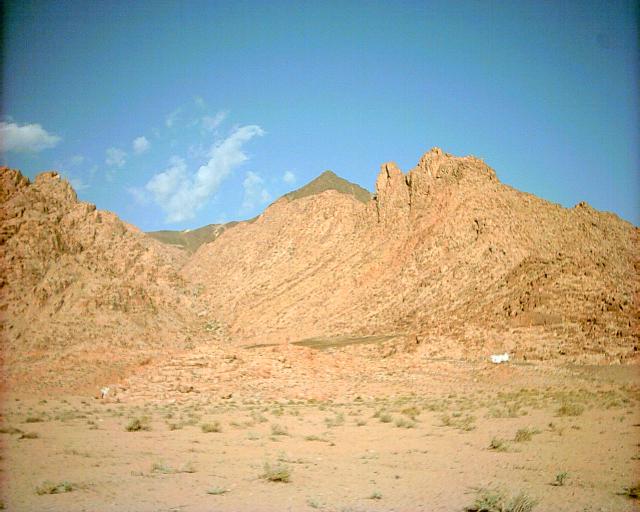
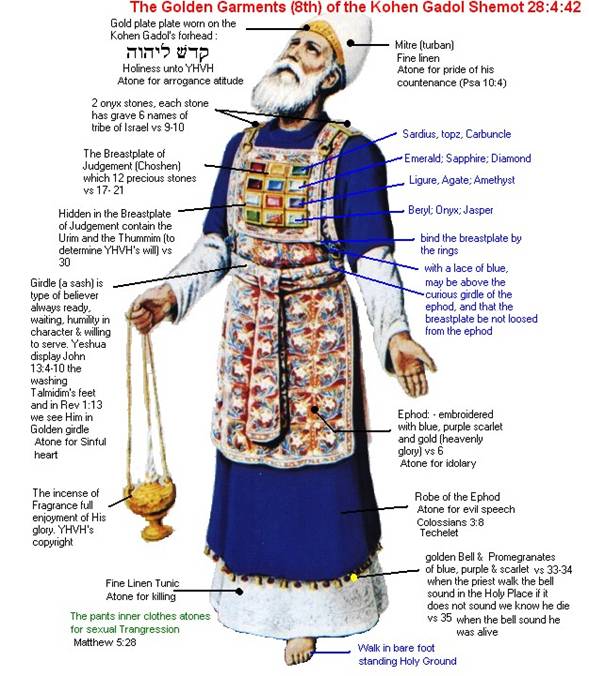
Note: you will need the oldheb.ttf (old Hebrew) and the SGreek Mediuim fonts to see the Hebrew and Greek text, as well as the three English fonts: Cooper Black, Impact and Frontlight MT Light. Right click the links and choose "Save Target As". Then go to the file, and either right click them and choose "install", or drag them into the font page.
oldheb.ttf
SGreek Medium
Cooper Black
Impact
Frontlight MT Light
NOTE: All of the yous and yours underlined as "you" and "your" indicates that the you and the your are plural. Also any of the words that are in bold pink lettering as "you" refers to the feminine gender, but it is only applied when it does not commonly refer to a woman. This only is applied to this week's Torah portion text at this time.
CHAPTER 27
Exodus 27:20-21
Exo 27:20 And you, you shall command ta-the Sons of Israel, and they shall take to you transparent olive oil beaten for the light, to ascend the Lamp continually. 21 In the Tent of Appointment from outside by the Veil, which is upon the Testimony (Witness), Aaron and his sons shall arrange him from mixing period (evening) until breaking period (morning) to the Face of hwhy: a Statute of Ages for their generations from ta the Sons of Israel.
(NOTE: Not all verses will have comments)
Looking at the word ARRANGE
The Hebrew word for arrange is "ah-rakh"- Ayin, Resh, Kaph Sophit (Kre). It is from Strong's Concordance number 6186, and its definition
A primitive root; to set in a row, that is, arrange, put in order (in a very wide variety of applications): - put (set) (the battle, self) in array, compare, direct, equal, esteem, estimate, expert [in war], furnish, handle, join [battle], ordain, (lay, put, reckon up, set) (in) order, prepare, tax, value.
Question: "Why are they only to furnish it at night and not during the day"? Is it because there is not much activity during the night at the Tabernacle? But they will be sacrificing animals for the Daily Sacrifices during the mixing period (evening) and breaking period (morning), which is noted in the Torah portion of Pinkhas, in the book of Numbers
Numbers 28:3 And you shall say to them, This is the Fire Offering which you shall bring near to hwhy; two perfect sheep of sons of a year, by the day, of a Continual Elevation Offering (Ascension Offering, Burnt Offering). 4 You shall do (offer) ta-the one sheep in the breaking period (morning), and you shall do (offer) ta the second sheep between the mixing periods (evenings);
The only answer I can think at this time is that it could connect to the account of the Exodus Passover when it was killed between the mixing periods (evenings) for the night period and to burn the remaining lamb in the breaking period (morning).
It is also hwhy that is telling us the Lamps needed to be refurnished in the new Biblical day, because the new day starts at sundown. We believers in Yeshua need to ask Abba Father to refresh us and renew us with the Ruakh HaKodesh (the Holy Spirit) daily as well, and is best to start asking Him at sundown. Also we need to ask our Heavenly Father to have us die to our flesh daily, which the apostle Paul noted in his letter to the assembly in Corinth
1 Corinthians 15:31 I protest by your rejoicing which I have in Messiah Yeshua our Lord, I die daily.
This is done by denying ourselves and taking our crosses as Yeshua said, which is noted in the Gospel of Luke
Luke 9:23 And He said to them all, If any man will come after Me, let him deny himself, and take up his cross daily, and follow Me.
I heard stories from sources that say if the Priests fall asleep, and the light goes out on the Menorah, that someone will light their Priestly Garments and start a fire on them that they wake up and run out of the Tabernacle. To me, that is ridiculous, and it is just a fable.
Looking at the word TESTIMONY (WITNESS)
The Hebrew word for Testimony (Witness) is "Ey-dooth"- Ayin, Dalet, Vav, Tav (twde). It is from Strong's Concordance number 5715, and its definition
Feminine of H5707; testimony: - testimony, witness.
from 5707 "eyd" (de), and its definition
From H5749 contracted; concretely a witness; abstractly testimony; specifically a recorder, that is, prince: - witness.
from 5749 "ood" (dwe), and its definition
A primitive root; to duplicate or repeat; by implication to protest, testify (as by reiteration); intensively to encompass, restore (as a sort of reduplication): - admonish, charge, earnestly, lift up, protest, call (take) to record, relieve, rob, solemnly, stand upright, testify, give warning, (bear, call to, give, take to) witness.
If this Hebrew word looks familiar, it is the similar Hebrew word "adath" (or "adat")
from Strong's Concordance number 5712 "ey-dah" (hde), and its definition
Feminine of H5707 in the original sense of fixture; a stated assemblage (specifically a concourse, or generally a family or crowd): - assembly, company, congregation, multitude, people, swarm. Compare H5713.
This is the similar Hebrew word for "congregation".
The Testimony is a witness from hwhy to "the Congregation". We as believers in Yeshua give our "testimony" to people in leading them to the testimony of the Messiah Yeshua, which the apostle Paul noted in his letters to the assemblies in Corinth and Thessalonica and in his letter to Timothy
1 Corinthians 1:5 That in every thing ye are enriched by Him, in all utterance, and in all knowledge; 6 Even as the Testimony of the Messiah was confirmed in you: 7 So that ye come behind in no gift; waiting for the coming of our Lord Yeshua, the Messiah: 8 Who shall also confirm you unto the end, that ye may be blameless in the day of our Lord Yeshua, the Messiah.
1 Corinthians 2:1 And I, brethren, when I came to you, came not with excellency of speech or of wisdom, declaring unto you the Testimony of hwhy.
2 Thessalonians 1:7 And to you who are troubled rest with us, when the Lord Yeshua shall be revealed from the heavens with his mighty angels, 8 In flaming fire taking vengeance on them that know not hwhy, and that obey not the Fospel of our Lord, Yeshua, the Messiah: 9 Who shall be punished with everlasting destruction from the Presence of hwhy, and from the Flory of His Power; 10 When he shall come to be glorified in His Saints, and to be admired in all them that believe (because our testimony among you was believed) in that day. 11 Wherefore also we pray always for you, that our Elohim would count you worthy of this calling, and fulfil all the good pleasure of His Goodness, and the work of faith with Power: 12 That the Name of our Lord Yeshua, the Messiah, may be glorified in you, and ye in Him, according to the Grace of our Elohim and the Lord Yeshua, the Messiah.
2 Timothy 1:8 Be not thou therefore ashamed of the Testimony of our Lord, nor of me His prisoner: but be thou partaker of the afflictions of the Gospel according to the Power of hwhy;
Also, the apostle John wrote this regarding the testimony of Yeshua, which is noted in the book of Revelation
Revelation 1:1 The Revelation of Yeshua, the Messiah, which hwhy gave unto Him, to shew unto His servants things which must shortly come to pass; and He sent and signified it by His angel unto His servant, John: 2 Who bare record of the Word of hwhy, and of the Testimony of Yeshua the Messiah, and of all things that He saw.
Mark Moses, formerly of El Shaddai Ministries, noted that we as believers are pressed, so that we would become "pure oil" in the Eyes of hwhy. Thank you Mark.
CHAPTER 28
Exodus 28:1-43
Exo 28:1 And you shall bring near to yourself ta-Aaron, your brother, and ta-his sons with him from the midst of the Sons of Israel for his Priestship (Priestly Acts) for Me; Aaron, Nadab and the Abihu, Eleazar, and Ithamar, the sons of Aaron. 2 And you shall do (make) Sacred (Holy) Garments for Aaron, your brother, for glory and for ornamentalness (gleamness, beauty). 3 And you, you shall speak to all of the wise at (of) heart which I have filled (consecrated) a Spirit of Wisdom, and they shall do (make) ta-the Garments of Aaron to sanctify him, for his Priestship (Priestly Acts) to Me.
4 And these are the Garments which they shall do (make); a Pocket (Breast Pocket), and and an Ephod, and an Outer Robe (Upper Robe) [(?Trespass Robe?, ?Transgressor Robe?)], and a Interwoven Coat (Tunic), a Turban (Miter), and a Girdle: and they shall do (make) Sacred (Holy) Garments for Aaron, your brother, and for his sons for his Priesthip (Priestly Acts) to Me.
5 And they, they shall take ta-the gold, and ta-the blue, and ta-the purple, and ta-the crimson (red) worm [(worm of crimson (red))], and ta-the linen (six stringed linen, six bleached linen, bleached linen, white linen), 6 and they shall do (make) ta-the Ephod of gold, of blue, and of purple, of the crimson (red) worm [(worm of crimson (red))], and of twisted (twined, fine) linen (six stringed linen, six bleached linen, bleached linen, white linen) from the doing (work) of a weaver (embroiderer, fabricator, deviser, interpenetrater). 7 Shall be for him two Upper Arm Corners (Shoulders) joined to his two ends (edges); and shall be joined. 8 And the Belt (Band) of his Ephod which is upon (over) him according to [(as)] his doing (work) from (with) him shall be gold, blue, and purple, and the crimson (red) worm [(worm of crimson (red))], and twisted (twined, fine) linen (six stringed linen, six bleached linen, bleached linen, white linen).
9 And you shall take ta-two Onyx Stones, and you shall engrave (carve, sculpt) upon (over) them the names of the Sons of Israel: 10 Six with their names shall be upon the one Stone, and ta-the remaining six names shall be upon the second Stone according to their births. 11 Of a doing (work) of an engraver (craftsman, artificer) of stone, like the engraving (carving, sculpting) of a signet (seal ring), you shall engrave (carve, sculpt) ta-the two Stones upon the names of the Sons of Israel: you shall do (make) them Enclosings of Broaches (Brocades, Ouches) of gold. 12 And you shall set (put) ta-the two Stones upon the Upper Arm Corners (Shoulders) of the Ephod for Stones of a Remembrance (Memorial) for the Sons of Israel: and Aaron shall bear (carry, lift up) ta-their names to the Face of hwhy upon his two Upper Arm Corners (Shoulders) for a Remembrance (Memorial). 13 And you shall do (make) Enclosings of Broaches (Brocades, Ouches) of gold;
14 And two Chains of pure gold from the borders (boundary), you shall do (make) them; of a doing (work) of a Cord (Wreath, Rope), and you shall give ta-the Chains of the Cords (Wreaths, Ropes) upon the Broaches (Brocades, Ouches).
15 And you shall do (make) the Pocket (Breast Pocket) of Judgment (Ordinance), a doing (work) of a weaver (embroiderer, fabricator, deviser, interpenetrater); you shall do (make) him like the doing (work) of the Ephod of gold, of blue, and of purple, and of crimson (red) worm [(worm of crimson (red))], and of twisted (twined, fine) linen (six stringed linen, six bleached linen, bleached linen, white linen) you shall do (make) him. 16 Shall be coupled square; a span shall be his length, and a span shall be his width. 17 And you shall fill (consecrate) in him fillings of Stones of four rows of stones. A row of a sardius (ruby), a topaz, and a carbuncle shall be the one row. 18 And the second row shall be an emerald (turquoise), a sapphire, and a diamond. 19 And the third row shall be a ligure (jacinth, opal), an agate, and an amethyst. 20 And the fourth row a beryl (chrysolite), and an onyx, and a jasper: inchased (interwoven, embroidered) of gold in their fillings. 21 And the Stones, they shall be upon the names of the two ten (twoteen, twelve) Sons of Israel, upon their names the engravings (carvings, sculptings) of a Signet (Seal Ring); A man upon his name they shall be for the two ten (twoteen, twelve) tribes.
22 And you shall do (make) upon the Pocket (Breast Pocket) of Chains at the borders (boundaries) of a doing (work) of Cords (Wreaths, Ropes) of pure gold. 23 And you shall do (make) upon the Pocket (Breast Pocket) two Rings of gold, and you shall give ta-the two Rings upon the two ends (edges) of the Pocket (Breast Pocket). 24 And you shall give ta-the two Cords (Wreaths) of the gold upon the two Rings to the ends (edges) of the Pocket (Breast Pocket). 25 And ta-the two ends (edges) of the two Cords (Wreaths, Ropes) you shall give upon the two Broaches (Brocades, Ouches), and give them upon the Upper Arm Corners (Shoulders) of the Ephod to before (the front of) his face. 26 And you shall do (make) two Rings of gold, and you shall set (put) them upon the two ends (edges) of the Pocket (Breast Pocket) upon his lip (edge) which is to over the Ephod housingward (inward). 27 And you shall do (make) two Rings of gold, and you shall give them upon the two Upper Arm Corners (Shoulders) of the Ephod from below (beneath), before (at the front of) his face, by associating (being along with, societizing, huddling together) his joining (juncture), from above (upon) the Belt (Band) of the Ephod. 28 And they shall bind ta-the Pocket (Breast Pocket) with his Rings to the Rings of the Ephod on a string (ribbon) of blue to be above (upon) the Belt (Band) of the Ephod, and the Pocket (Breast Pocket) shall not be loosed (displaced) from upon the Ephod. 29 And Aaron shall bear (carry, lift up) ta-the names of the Sons of Israel on the Pocket (Breast Pocket) of the Judgment (Ordinance) over (upon) his heart, in his going to the Sacred Area (Holy Area), for a Remembrance (Memorial) to the Face of hwhy continually.
30 And you shall give to the Pocket (Breast Pocket) of the Judgment (Ordinance) ta-the Urim and ta-the Thummim; and they shall be over (upon) the heart of Aaron in his going (entering) to the Face of hwhy: and Aaron shall bear (carry, lift up) ta-the Judgment (Ordinance) of the Sons of Israel over (upon) his heart to the Face of hwhy continually.
31 And you shall do (make) ta-the Outer Robe (Upper Robe) [(?Trespass Robe?, ?Transgressor Robe?)] of the Ephod wholly of blue. 32 And shall be the mouth of his head in his midst: a lip shall be to his mouth all around, a doing (work) of a braider (rugger, weaver) like the mouth of a habergeon (corselet, sleeveless coat, ?glow coat?, ?armored mail?) shall be to him. Shall not be rent. 33 And you shall do (make) upon his Hem Pomegranates of blue, and of purple, and of crimson (red) worm [(worm of crimson (red))] upon his Hem all around; and Round Bells of gold in their midst all around: 34 A Round Bell of gold and a Pomegranate, a Round Bell of gold and a Pomegranate upon the Hem of the Outer Robe (Upper Robe) [(?Trespass Robe?, ?Transgressor Robe?)] all around. 35 And shall be upon (over) Aaron for the Ministry [(for ministering)]: and his sound shall be heard in his entering to the Sacred Area (Sanctuary, Holy Area) to the Face of hwhy, and in his coming out (going out); and shall not die.
36 And you shall do (make) a Plate of pure gold, and you shall engrave (carve, sculpt) upon him, an engraving (carving, sculpting) of a signet (seal ring), SACREDNESS (SACRED, HOLINESS, HOLY) TO YAHWAH. 37 And you shall set (put) him upon a thread of blue, and shall be upon (over) the Turban (Miter); shall be to before (at the front of) the face of the Turban (Miter). 38 And shall be upon the forehead of Aaron, and Aaron shall bear (carry, lift up) ta-the Iniquity of the Sacred Things (Holy Things) which the Sons of Israel, they shall sanctify to all of their Sacred (Holy) Gifts; and shall be upon his forehead continually for acceptance (delight) for them to the Face of hwhy.
39 And you shall interweave (embroider, inchase) the Coat (Tunic) of linen (six-bleached linen, bleached linen, white linen), and you shall do (make) the Turban (Miter) of twisted (twined, fine) linen (six stringed linen, six bleached linen, bleached linen, white linen), and you shall do (make) the Girdle of a doing (work) of a needler (fabricator, texturer, cunning work). 40 And for the sons of Aaron, you shall do (make) Coats (Tunics), and you shall do (make) for them Girdles, and you shall do (make) for them Bonnets for glory and for ornamentalness (gleamness, beauty).
41 And you shall clothe them, ta-Aaron your brother, and ta-his sons with him; and you shall anoint them, and you shall fill (consecrate) ta-their hands, and you shall sanctify them, and they shall do the Priestship (Priestly Acts) to Me.
42 And shall do (make) for them Breeches of bahd-linen (flax) to cover (conceal) the flesh of the nakedness; they shall be from their waist (loins) and unto their thighs (testacles): 43 And they shall be upon Aaron and upon his sons in their entering (going) to the Tent of Appointment, or in their approaching to the Altar to minister in the Sacred Area (Holy Area); and they shall not bear (carry, lift up) iniquity, and they shall have the death [(and they would die)]: A Statute of Ages to him and to his seed after him.
(NOTE: Not all verses will have comments)
Verses one through four
1 And you shall bring near to yourself ta-Aaron, your brother, and ta-his sons with him from the midst of the Sons of Israel for his Priestship (Priestly Acts) for Me; Aaron, Nadab and the Abihu, Eleazar, and Ithamar, the sons of Aaron. 2 And you shall do (make) Sacred (Holy) Garments for Aaron, your brother, for glory and for ornamentalness (gleamness, beauty). 3 And you, you shall speak to all of the wise at (of) heart which I have filled (consecrated) a Spirit of Wisdom, and they shall do (make) ta-the Garments of Aaron to sanctify him, for his Priestship (Priestly Acts) to Me. 4 And these are the Garments which they shall do (make); a Pocket (Breast Pocket), and and an Ephod, and an Outer Robe (Upper Robe) [(?Trespass Robe?, ?Transgressor Robe?)], and a Interwoven Coat (Tunic), a Turban (Miter), and a Girdle: and they shall do (make) Sacred (Holy) Garments for Aaron, your brother, and for his sons for his Priesthip (Priestly Acts) to Me.
Notice it did not say the Levites, but Aaron and his four sons. hwhy is focusing on the main Aaronic line to do the services in the Tent of Appointment. As realized, Yeshua will come from the lineage of Aaron. The only source that proves this is noted in the Gospel of Luke
Luke 1:5 There was in the days of Herod, the king of Judaea, a certain Priest named Zacharias, of the course of Abia: and his wife was of the daughters of Aaron, and her name was Elisabeth.... 24 And after those days his wife Elisabeth conceived, and hid herself five months,... 26 And in the sixth month the angel Gabriel was sent from hwhy unto a city of Galilee, named Nazareth, 27 To a virgin espoused to a man whose name was Joseph, of the house of David; and the virgin's name was Mary.... 34 Then said Mary unto the angel, How shall this be, seeing I know not a man? 35 And the angel answered and said unto her, The Holy Spirit shall come upon thee, and the Power of the Highest shall overshadow thee: therefore also that Holy Thing which shall be born of thee shall be called the Son of Elohim. 36 And, behold, thy cousin Elisabeth, she hath also conceived a son in her old age: and this is the sixth month with her, who was called barren.
Elizabeth was from the line of Levi, in which she was most likely of the line of Aaron. Mary was Elizabeth's cousin, meaning that they would have at minimum a common Aaronite grandfather, proving that Mary was also of the line of Aaron.
In verse three of this week's Torah portion passage, the men were given widsom to make the Priestly Garments. One can say that we in Messiah are filled with the Ruakh HaKodesh (the Holy Spirit) who gives us the wisdom to do Priestly Acts for the Kingdom, because Yeshua made us Priests which the apostle John noted in the book of Revelation
Revelation 1:5 And from Yeshua Messiah, who is the Faithful Witness, and the First Begotten of the Dead, and the Prince of the kings of the earth. Unto Him that loved us, and washed us from our sins in His own Blood, 6 And hath made us kings and priests unto hwhy and His Father; to Him be Glory and Dominion for ages and until. Amen.
Also, the apostle Peter noted it in his epistle
1 Peter 2:5 Ye also, as Lively Stones, are built up a Spiritual House, an Holy Priesthood, to offer up Spiritual Sacrifices, acceptable to hwhy by Yeshua, the Messiah.
Verses five through eight
THE EPHOD
5 And they, they shall take ta-the gold, and ta-the blue, and ta-the purple, and ta-the crimson (red) worm [(worm of crimson (red))], and ta-the linen (six stringed linen, six bleached linen, bleached linen, white linen), 6 and they shall do (make) ta-the Ephod of gold, of blue, and of purple, of the crimson (red) worm [(worm of crimson (red))], and of twisted (twined, fine) linen (six stringed linen, six bleached linen, bleached linen, white linen) from the doing (work) of a weaver (embroiderer, fabricator, deviser, interpenetrater). 7 Shall be for him two Upper Arm Corners (Shoulders) joined to his two ends (edges); and shall be joined. 8 And the Belt (Band) of his Ephod which is upon (over) him according to [(as)] his doing (work) from (with) him shall be gold, blue, and purple, and the crimson (red) worm [(worm of crimson (red))], and twisted (twined, fine) linen (six stringed linen, six bleached linen, bleached linen, white linen).
THE SYMBOLIC MEANINGS OF THE EPHOD
Gold: Kingdom, Eternal, Perfection
Blue: Heaven
Purple: Royalty
Crimson worm (Red): Blood, Atonement, Sacrifice
Twisted linen: Righteousness (source: maranathalife.com)
GENDER:
Ephod: MALE
Corners (Shoulders): FEMALE
Belt (Band): (FEMALE?)
Looking at the word EPHOD
The Hebrew word for Ephod is "ey-phohd"- Aleph, Peh, Vav, Dalet (dwpa). It is from Strong's Concordance number 646, and its definition
Second form is a rare form; probably of foreign derivation; a girdle; specifically the ephod or high priest’s shoulder piece; also generally an image: - ephod.
This was the High Priest's Apron.
These colors are to be sewn together. It does not say whether the colors are to be woven together as one string each before they are weaved, or blend the individual colored strings together to form a multi-color garment. It was most likely that the individual colors were woven together, but not in a pattern, just randomly woven.
This image in general, though not a perfect one, is the best idea what the colored threads would look like when woven together to form the Ephod
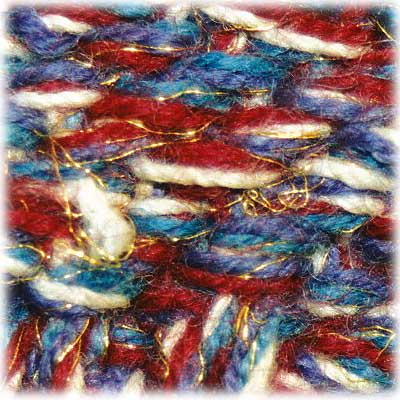
The reason I say this is becuase it details more what to do with the gold for the Ephod, which is noted in the Torah portion of P'kudey, in the book of Exodus
Exodus 39:1 And from the blue, and the purple, and the crimson (red) worm [(worm of crimson (red))], they did (made) Stitched Garments for the Service in the Sanctuary, and they did (made) ta-the Sacred (Holy) Garments which were for Aaron; as the which hwhy commanded ta-Moses. 2 And did (made) ta-the Ephod of gold, blue, and purple, and the crimson (red) worm [(worm of crimson (red))], and twisted (twined) linen (six stringed linen, six bleached linen, bleached linen, white linen). 3 And they pounded (beaten, hammered) ta-the sheets of the gold and had cut (chopped) threads to do (work) in the midst of the blue, and in the midst of the purple, and in the midst of the crimson (red) worm [(worm of crimson (red))], and in the midst of the linen (six stringed linen, six bleached linen, bleached linen, white linen), the work of a weaver (embroiderer, fabricator, deviser, interpenetrater).
In other words, a thread of gold was threaded into "each" of the red threads, the blue threads, the linen threads, and the purple threads. The application of the gold in the each of the differnet colored threads is symbolic of the eternalness of each meaning of the colors, and this is what they represent:
Gold in the Crimson worm (Red): Eternal Blood, Atonement and Sacrifice of Yeshua
Gold in the Blue: Eternal Heavenly Presence of Yeshua
Gold in the Purple: Eternal Kingship of Yeshua
Gold in the Linen: Eternal Purity of Yeshua
These are the best examples by far of what the gold is like in each of the colored strings. This kind of string is called the Lirux string
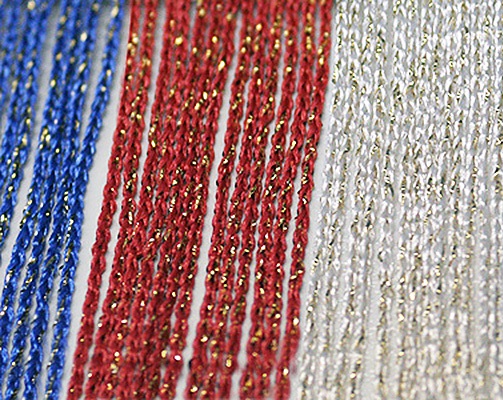
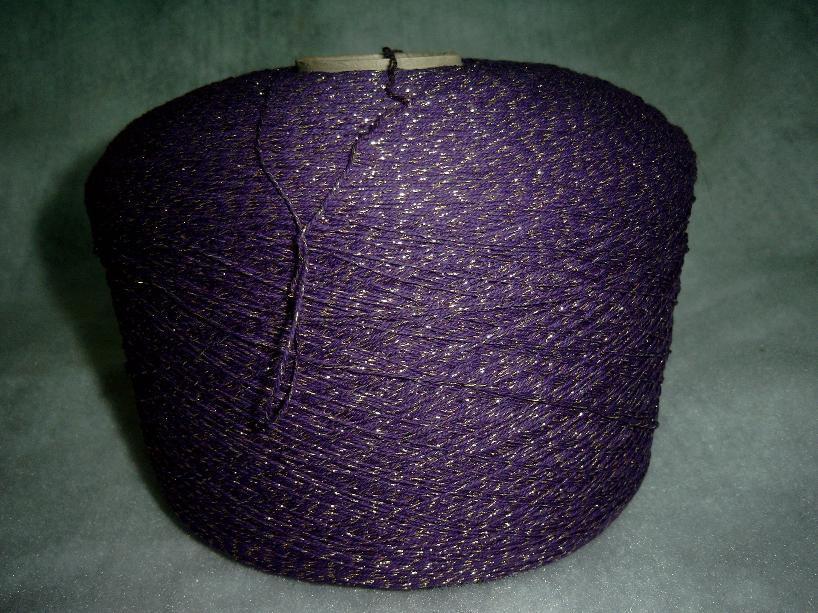
Apply these strings to the image of the different colored strings woven as posted previously, and you can get a good idea what the Ephod really looks like. Just add some eye shades, a disco ball and........ oh, never mind.
If one notices, that this style of string gives off a reflective effect from the gold in the string. This is most likely why hwhy wanted this string set up so that when the High Priest approaches the Ark of the Covenant, hwhy's Glory would "reflect" His Eternalness through the gold threads in each of the colored strings.
!!!hwhy Kl dbk
Looking at the following words:
LINEN (SIX STRINGED LINEN, SIX BLEACHED LINEN, BLEACHED LINEN, WHITE LINEN)
The Hebrew word for linen (six stringed linen, six bleached linen, bleached linen, white linen) is "sheysh"- Shin, Shin (ss) It is from Strong's Concordance number 8336, and its definition
...for H7893; bleached stuff, that is, white linen or (by analogy) marble: - X blue, fine [(twined]) linen, marble, silk.
This is the same word from 8337 "sheysh" (ss), and its definition
...a primitive number; six (as an overplus (see H7797) beyond five or the fingers of the hand); as ordinal sixth: - six ([-teen, -teenth]), sixth.
TWISTED (TWINED, FINE)
The Hebrew word for twisted (twined, fine) is "shah-zahr"- Shin, Zayin, Resh (rzs) (in the Hebrew text "mash-zahr" (rzsm) It is from Strong's Concordance number 7806, and its definition
A primitive root; to twist (a thread of straw): - twine.
The Hebrew word sheysh is the same Hebrew word for the number "six". By the way, the Mexican number for six is "seis", and it came from the Sephardic Ladino Jews who migrated there. It is known that two thirds of the Mexicans are of Jewish descent.
I'm still trying to figure out the structure of the Ephod. When I figure it out, I will post it.
Verses nine through thirteen
THE ONYX STONES AND BROCADES
9 And you shall take ta-two Onyx Stones, and you shall engrave (carve, sculpt) upon (over) them the names of the Sons of Israel: 10 Six with their names shall be upon the one Stone, and ta-the remaining six names shall be upon the second Stone according to their births. 11 Of a doing (work) of an engraver (craftsman, artificer) of stone, like the engraving (carving, sculpting) of a signet (seal ring), you shall engrave (carve, sculpt) ta-the two Stones upon the names of the Sons of Israel: you shall do (make) them Enclosings of Broaches (Brocades, Ouches) of gold. 12 And you shall set (put) ta-the two Stones upon the Upper Arm Corners (Shoulders) of the Ephod for Stones of a Remembrance (Memorial) for the Sons of Israel: and Aaron shall bear (carry, lift up) ta-their names to the Face of hwhy upon his two Upper Arm Corners (Shoulders) for a Remembrance (Memorial). 13 And you shall do (make) Enclosings of Broaches (Brocades, Ouches) of gold;
THE SYMBOLIC MEANINGS OF THE ONYX STONES AND BROACHES
Gold: Kingdom, Eternal, Perfection
Onyx Stones: Purity
GENDER:
Onyx Stones: FEMALE
Broaches: FEMALE(?)
The onyx stone is a black stone. Onyx also comes in pale green and in red. It is was most likely in black.
In verse ten of this week's Torah portion passage, the order of the names in each of the two onyx stones were based on the order of their births. That means the first six sons that were born to Jacob were on one plate and the second six sons that were born/adopted to Jacob were on the second stone. The reason I noted in the second stone "born/adopted", because Jacob adopted Ephraim and Manasseh as his sons, which is noted in the Torah portion of Va-Y'khi, in the book of Genesis
Genesis 48:5 And now two of your sons that were [(the ones)] birthed to you in the land of Egypt until my coming to you to Egypt, they shall belong to me; Ephraim and Manasseh, as Reuben and Simeon, they shall belong to me.
Joseph was the second to the last born to Jacob, but Ephraim and Manasseh were the next generation and were adopted by Jacob. So what does this mean when hwhy said the twelve sons in the order of their births? Does it mean the original twelve sons born to Jacob, or does that mean that Benjamin was placed as third to the last and Manasseh the second to last and Ephraim last, or would Manasseh and Ephraim be third and second last in place of Joseph, because they substituted Joseph's position and Benjamins stays last?
This is what the Oxford Dictionary on Yahoo's search defines a brocade:
"a rich fabric, usually silk, woven a raised pattern, typically with gold or silver thread"
I don't know if the brocades for the onyx stones are threaded gold pouches or plaited gold setting to hold the onyx stones in place.
Going back to the actual time it was made, the text was etched in ancient Paleo-Hebrew, and not the square Babylonian modern Hebrew text.
Looking at the following words:
ENGRAVE (CARVE, SCULPT)
The Hebrew word for engrave (carve, sculpt) is "pah-thakh"- Peh, Tav, Khet (xtp) It is from Strong's Concordance number 6605, and its definition
A primitive root; to open wide (literally or figuratively); specifically to loosen, begin, plough, carve: - appear, break forth, draw (out), let go free, (en-) grave (-n), loose (self), (be, beset) open (-ing), put off, ungird, unstop, have vent.
ENGRAVER (CRAFTSMAN, ARTIFICER)
The Hebrew word for engraver (craftsman, artificer) is "Khah-rahsh"- Khet, Resh, Shin (srx) It is from Strong's Concordance number 2796, and its definition
From H2790; a fabricator of any material: - artificer, (+) carpenter, craftsman, engraver, maker, + mason, skilful, (+) smith, worker, workman, such as wrought.
This is the same word from 2790 "khah-rahsh" (srx), and its definition
A primitive root; to scratch, that is, (by implication) to engrave, plough; hence (from the use of tools) to fabricate (of any material); figuratively to devise (in a bad sense); hence (from the idea of secrecy) to be silent, to let alone; hence (by implication) to be deaf (as an accompaniment of dumbness): - X altogether, cease, conceal, be deaf, devise, ear, graven, imagine, leave off speaking, hold peace, plow (-er, -man), be quiet, rest, practise secretly, keep silence, be silent, speak not a word, be still, hold tongue, worker.
The key words that stick out to me in these two definitions are "ungirded", "carve" and "silent". It was like these two words provided a code that a person would be ungirded, and carved, or "whipped" having the flesh carved or "ripped", and be silent about it. This is fulfilled when Yeshua taken to the Roman authorities and Pontius Pilate had Him whipped, and Yeshua kept silent throughout the process to be crucified.
!!!hwhy Kl dbk
This is an image of a general idea what the two onyx stones in the golden brocades could look like
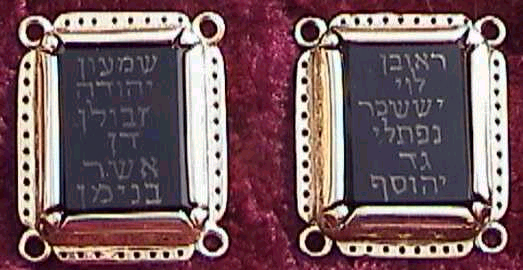
This is the first possiblilty of the names written in the Onyx stones with the originial twelve brothers in the order of their births in the original Paleo-Hebrew text
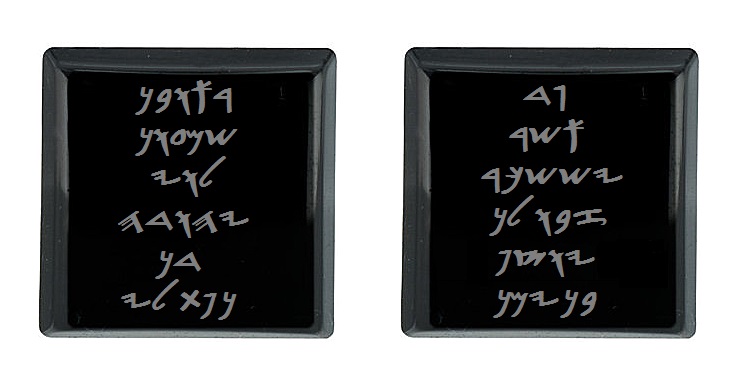
This is the second possible etching of the order of the twelve Sons of Israel by removing Levi and subsituting Joseph with Manasseh and Ephraim
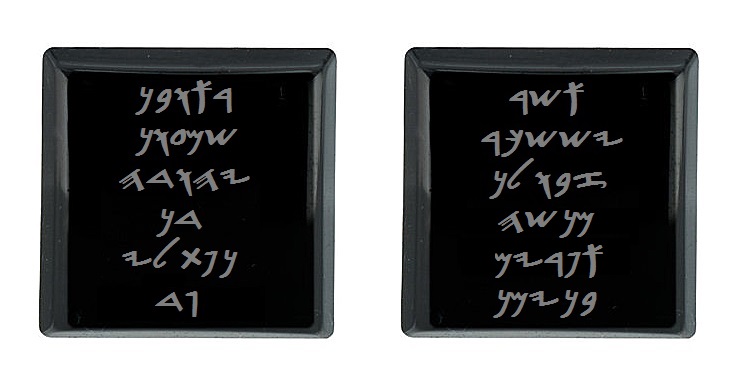
This is the third possible etching of the order of the twelve Sons of Israel by removing Levi and switching Benjamin with Manasseh and Ephraim
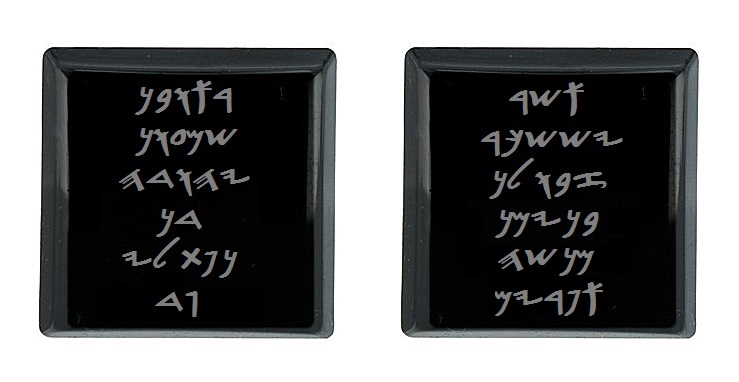
Also, according to http://maranathalife.com, the symbol for onyx is "the church", but if we put the symbolic meaning in its Biblical context, it would be "the Assembly" or "the Congregation". This would make more sense, since the twelve tribal names would be put on the two onyx stones.
Bill Cloud of Shoreshim Ministries noted this incredible revelation, which he noted of a verse in the book of the prophet Isaiah
Isaiah 9:6 For Child shall be born unto us, a son is given unto us: and the government, she shall be upon His Shoulders: and His Name shall be called Wonderful, Counsellor, the Mighty El, the Everlasting Father, The Prince of Peace.
Bill Cloud noted that this verse with the phrase "and the government, she shall be upon His Shoulders" refers the shoulders to the two onyx stones with the twelve tribes engraved on the shoulders the High Priest, and that Yeshua bears these onyx stones containing the twelve tribes on His Shoulders, becuase Yeshua is the current and Eternal High Priest. Thank you Bill Cloud.
Indirectly related, it is well established that the place, Shechem, means "shoulders". This is the same location that Abraham, Jacob passed through during their time, and the Israelites would be passing by in a future time. It is most likely Moses knew that this location would provide a full human view demonstration of the two Shoulder Pieces on the High Priest. That must have been a sight to see. This is where the blessing and the curses.
Mount Gerizim, located south, likening it to the shoulder of the High Priest, would be located on the "right shoulder", the same direction the Tent of Appointment would be facing. The right side of the shoulder is the "strong side", and this is the side the blessings are located. Mount Ebal, located north, would be on the left shoulder, which is the "weak side", and this is where the curses would be located.
These are images of Mount Gerazim and Mount Ebal, located in Nablus, also known in Biblical times as Shechem
This is a Panorama view of the two Mountains in Shechem. The second image shows the names of the two mountains of Mount Gerizim and Mount Ebal with Shechem in between the mountains


This same shows the comparison to the High Priest's shoulder pieces

Verse fourteen
THE TWO CHAINS
14 And two Chains of pure gold from the borders (boundary), you shall do (make) them; of a doing (work) of a Cord (Wreath, Rope), and you shall give ta-the Chains of the Cords (Wreaths, Ropes) upon the Broaches (Brocades, Ouches).
15 And you shall do (make) the Pocket (Breast Pocket) of Judgment (Ordinance), a doing (work) of a weaver (embroiderer, fabricator, deviser, interpenetrater); you shall do (make) him like the doing (work) of the Ephod of gold, of blue, and of purple, and of crimson (red) worm [(worm of crimson (red))], and of twisted (twined, fine) linen (six stringed linen, six bleached linen, bleached linen, white linen) you shall do (make) him. 16 Shall be coupled square; a span shall be his length, and a span shall be his width. 17 And you shall fill (consecrate) in him fillings of Stones of four rows of stones. A row of a sardius (ruby), a topaz, and a carbuncle shall be the one row. 18 And the second row shall be an emerald (turquoise), a sapphire, and a diamond. 19 And the third row shall be a ligure (jacinth, opal), an agate, and an amethyst. 20 And the fourth row a beryl (chrysolite), and an onyx, and a jasper: inchased (interwoven, embroidered) of gold in their fillings. 21 And the Stones, they shall be upon the names of the two ten (twoteen, twelve) Sons of Israel, upon their names the engravings (carvings, sculptings) of a Signet (Seal Ring); A man upon his name they shall be for the two ten (twoteen, twelve) tribes.
22 And you shall do (make) upon the Pocket (Breast Pocket) of Chains at the borders (boundaries) of a doing (work) of Cords (Wreaths, Ropes) of pure gold. 23 And you shall do (make) upon the Pocket (Breast Pocket) two Rings of gold, and you shall give ta-the two Rings upon the two ends (edges) of the Pocket (Breast Pocket). 24 And you shall give ta-the two Cords (Wreaths) of the gold upon the two Rings to the ends (edges) of the Pocket (Breast Pocket). 25 And ta-the two ends (edges) of the two Cords (Wreaths, Ropes) you shall give upon the two Broaches (Brocades, Ouches), and give them upon the Upper Arm Corners (Shoulders) of the Ephod to before (the front of) his face. 26 And you shall do (make) two Rings of gold, and you shall set (put) them upon the two ends (edges) of the Pocket (Breast Pocket) upon his lip (edge) which is to over the Ephod housingward (inward). 27 And you shall do (make) two Rings of gold, and you shall give them upon the two Upper Arm Corners (Shoulders) of the Ephod from below (beneath), before (at the front of) his face, by associating (being along with, societizing, huddling together) his joining (juncture), from above (upon) the Belt (Band) of the Ephod. 28 And they shall bind ta-the Pocket (Breast Pocket) with his Rings to the Rings of the Ephod on a string (ribbon) of blue to be above (upon) the Belt (Band) of the Ephod, and the Pocket (Breast Pocket) shall not be loosed (displaced) from upon the Ephod. 29 And Aaron shall bear (carry, lift up) ta-the names of the Sons of Israel on the Pocket (Breast Pocket) of the Judgment (Ordinance) over (upon) his heart, in his going to the Sacred Area (Holy Area), for a Remembrance (Memorial) to the Face of hwhy continually.
THE SYMBOLIC MEANINGS OF THE TWO CHAINS
Gold: Kingdom, Eternal, Perfection
GENDER:
Chains/Cord (Wreath): FEMALE
LOOKING AT THE WORD CHAIN
The Hebrew word for chain is "shahr-sh'rah"- Shin, Resh, Shin, Resh, Heh (hrsrs) It is from Strong's Concordance number 8333, and its definition
From H8327 (compare H8331); a chain; (architecturally) probably a garland: - chain.
This is the same word from 8327 "shah-rahsh" (srs), and its definition
A primitive root; to root, that is, strike into the soil, or (by implication) to pluck from it: - (take, cause to take) root (out).
The root definitions point out at me are "strike into the soil" and "pluck". This to me defines Yeshua how He was struck into the soil be being buried in Joseph's new tomb, and that He was plucked up, or "resurrected" from the tomb from the dead, and is alive.
!!!hwhy Kl dbk
The two gold chains symbolize the eternalness of the two houses of Israel.
This is an image example of the two chains
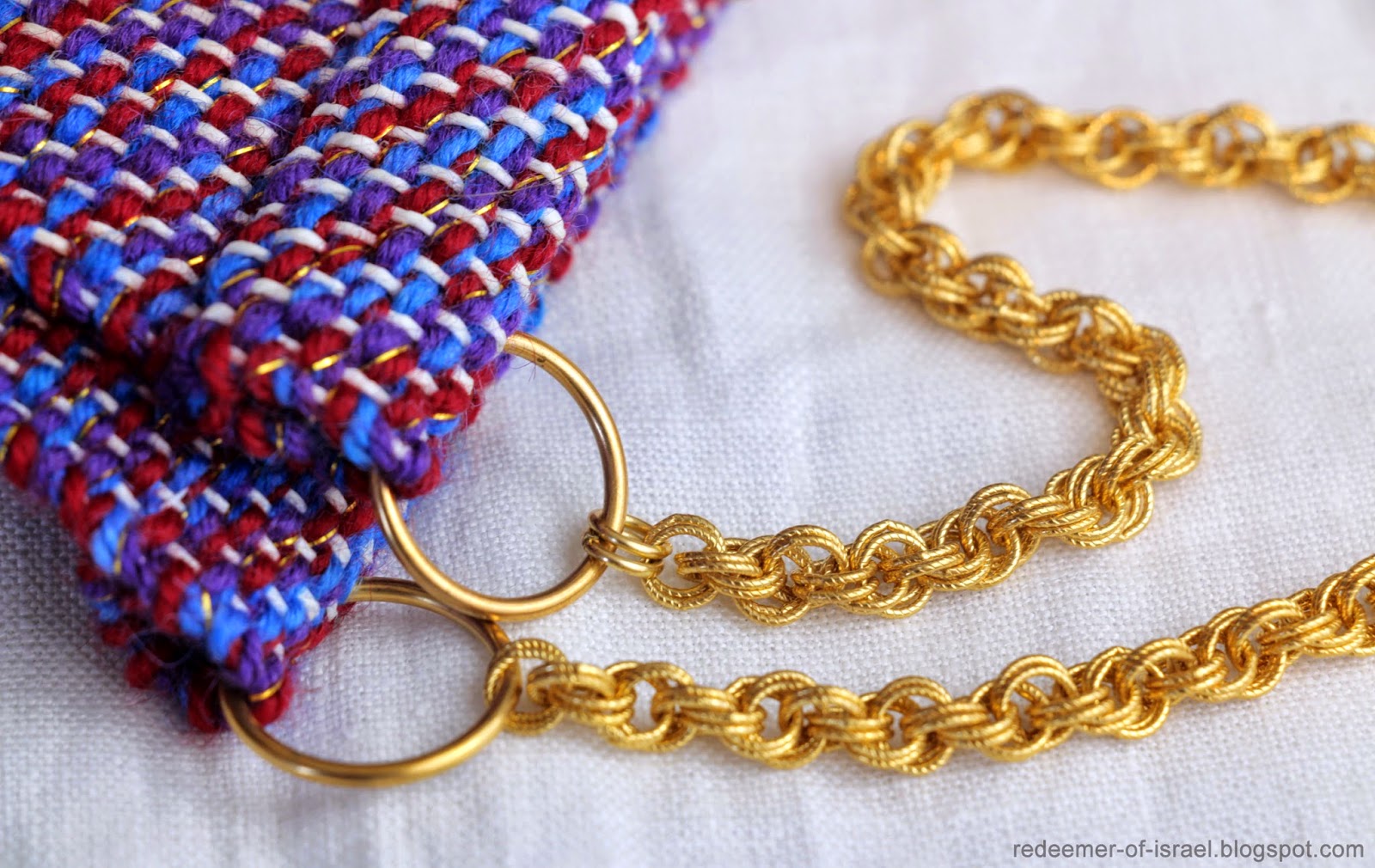
Verses fifteen through twenty-one
THE POCKET (BREAST POCKET)
15 And you shall do (make) the Pocket (Breast Pocket) of Judgment (Ordinance), a doing (work) of a weaver (embroiderer, fabricator, deviser, interpenetrater); you shall do (make) him like the doing (work) of the Ephod of gold, of blue, and of purple, and of crimson (red) worm [(worm of crimson (red))], and of twisted (twined, fine) linen (six stringed linen, six bleached linen, bleached linen, white linen) you shall do (make) him. 16 Shall be coupled square; a span shall be his length, and a span shall be his width. 17 And you shall fill (consecrate) in him fillings of Stones of four rows of stones. A row of a sardius (ruby), a topaz, and a carbuncle shall be the one row. 18 And the second row shall be an emerald (turquoise), a sapphire, and a diamond. 19 And the third row shall be a ligure (jacinth, opal), an agate, and an amethyst. 20 And the fourth row a beryl (chrysolite), and an onyx, and a jasper: inchased (interwoven, embroidered) of gold in their fillings. 21 And the Stones, they shall be upon the names of the two ten (twoteen, twelve) Sons of Israel, upon their names the engravings (carvings, sculptings) of a Signet (Seal Ring); A man upon his name they shall be for the two ten (twoteen, twelve) tribes.
THE SYMBOLIC MEANINGS OF THE POCKET (BREAST POCKET)
Gold: Kingdom, Eternal, Perfection
Blue: Heaven
Purple: Royalty
Crimson worm: Blood, Atonement, Sacrifice
Fine linen: Righteousness (source: maranathalife.com)
Onyx Stone/The Twelve Stones: Purity
GENDER:
Pocket (Breast Pocket): MALE
Fillings (Settings) of Stones: FEMALE
Looking at the word BROCADE
The Hebrew word for brocade is "meesh-b'tsah"- Mem, Shin, Bet, Tsade, Heh (hubsm). It is from Strong's Concordance number 4865, and its definition
From H7660; a brocade; by analogy a (reticulated) setting of a gem: - ouch, wrought.
from 7660 "shahv-vats" (ubs), and its definition
A primitive root; to interweave (colored) threads in squares; by implication (of reticulation) to inchase gems in gold: - embroider, set.
It is made with the same materials as the ephod.
Notice that it does not say how the order of the tribal names are placed on the stones. One theory is the names are placed based on the birth order of the twelve brothers. As I noted earlier, there are three possiblilites of the order of the twelve sons. So there is a strong possibility that this could be the answer.
Another theory is that the names of the sons are set in order based on the encampment order in the book of Numbers chapter two starting with Judah. The problem is that it did not occur until after the garments were made known. Unless there is an actual naming of each son for each stone, there is no way to know who was placed where in the stones. This is unlikely the answer.
Most likely, the order of the stones in each of the four rows went from right to left, like the writing of the Hebrew text.
There is confusion on the translations to what these twelve stones were. These are examples regarding the first row of stones from verse seventeen of this week's Torah portion passage in some Bible versions:
(JPS) And thou shalt set in it settings of stones, four rows of stones: a row of carnelian, topaz, and smaragd shall be the first row;
(Brenton) And thou shalt interweave with it a texture of four rows of stone; there shall be a row of stones, a sardius, a topaz, and emerald, the first row.
(Bishops) And thou shalt fill it with foure rowes of stones: in the first rowe shalbe a Sardius, a Topas, and Smaragdus.
(Geneva) Then thou shalt set it full of places for stones, euen foure rowes of stones: the order shalbe this, a rubie, a topaze, and a carbuncle in the first rowe.
(ESV) You shall set in it four rows of stones. A row of sardius, topaz, and carbuncle shall be the first row;
(KJV) And thou shalt set in it settings of stones, even four rows of stones: the first row shall be a sardius, a topaz, and a carbuncle: this shall be the first row.
(MKJV) And you shall set in it settings of stones, four rows of stones. The first row shall be a ruby, topaz, and carbuncle in the row.
(The Scriptures 1998+) “And you shall put settings of stones in it, four rows of stones: The first row is a ruby, a topaz, and an emerald;
(NET) You are to set in it a setting for stones, four rows of stones, a row with a ruby, a topaz, and a beryl — the first row;
and of course, my translation.
On the first stone, it is a debate between a sardius and ruby. This third stone is between an emerald, a carbuncle and a smaragdus. There is no clarity regarding these stones.
The twelve stones represent purity, meaning that the twelve tribes were "pure" tribes.
Indirectly related, the apostle Peter related the believers in Yeshua as "living stones in his book", which is noted in his epistle
1 Peter 2:5 Ye also, as Lively Stones, are built up a Spiritual House, an Holy Priesthood, to offer up Spiritual Sacrifices, acceptable to hwhy by Yeshua, the Messiah.
Also we in Messiah are tried through the fire of life in order to become His "precious stones".
In verse sixteen of this week's Torah portion passage, the length of a span is nine inches.
Wikipedia has a link regarding the twelve stones of the breastplate of judgment. You can find it by clicking on the link below to get to the webpage.
http://en.wikipedia.org/wiki/Priestly_breastplate
The thing that came to my attention is that the Breastplate of the Judgment is connected with the two Gold Chains to the two Shoulder Pieces in which the two Onyx Stones bear the names of the twelve tribes are located. Question: "Why is that"? It is like the six tribes on Mount Gerizim- the mountain of blessing and the other tribes on Mount Ebal- the mountain of cursing and they both come together to the Breastplate of Judgment for righteous sake: judgment for blessing or judgment for cursing.
Also the name for Levi means "joined". So one can say that the Levitical High Priest is symbolicaly "joining" together the two sets of Onyx Stones containing all twelve tribes together to the one breastplate.
In verse twenty-one of this week's Torah portion passage, the Hebrew word phrase for they is "tee-h'yeyn" (Nyyht). As I mentnioned in the Torah portion of T'rumah, in the book of Exodus, it is in the feminine plural, meaning that these stones are feminine.
These are some images of different examples of the Breast Pocket with the twelve stones.
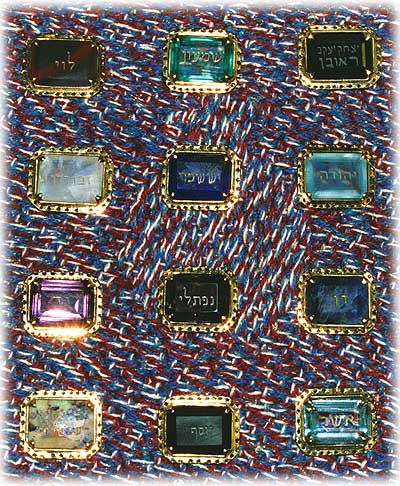
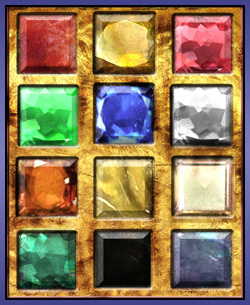
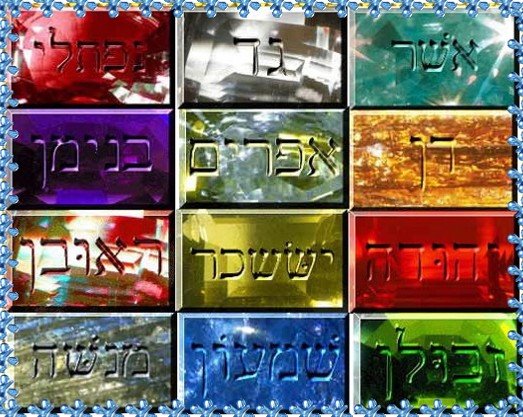
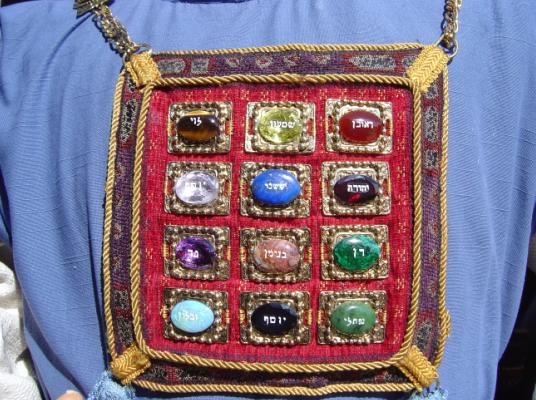
I have taken an image of the twelve stones and added the Paleo-Hebrew text into each of them for the three possiblilites of the order of the twelve Sons of Israel. I did one set all in plain white and did the other set as best as I could with the colors to best match the colors of each of the stones to give it more authenticy.
Ignoring the fabric background, this is the first order possiblity with the original twelve brothers who were born to Jacob
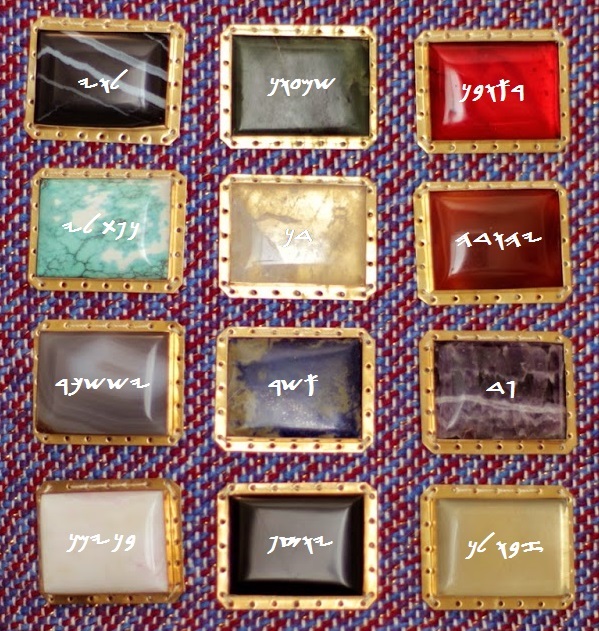
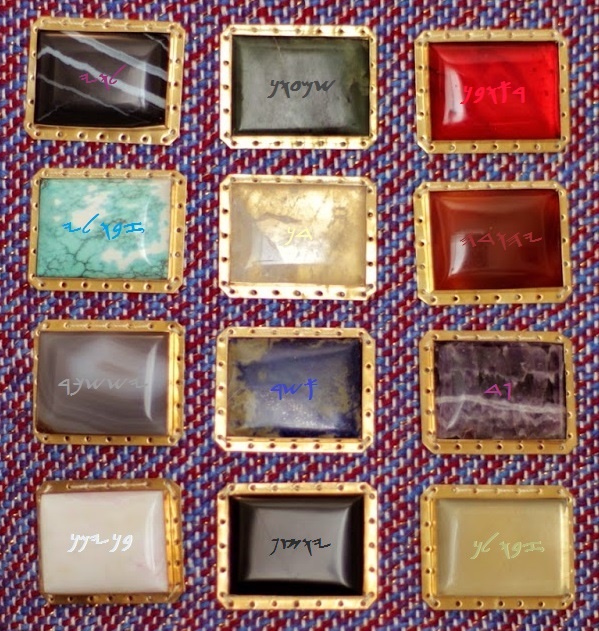
This is the second order possiblity of the order of the twelve Sons of Israel excluding Levi and replacing Joseph with Manasseh and Ephraim
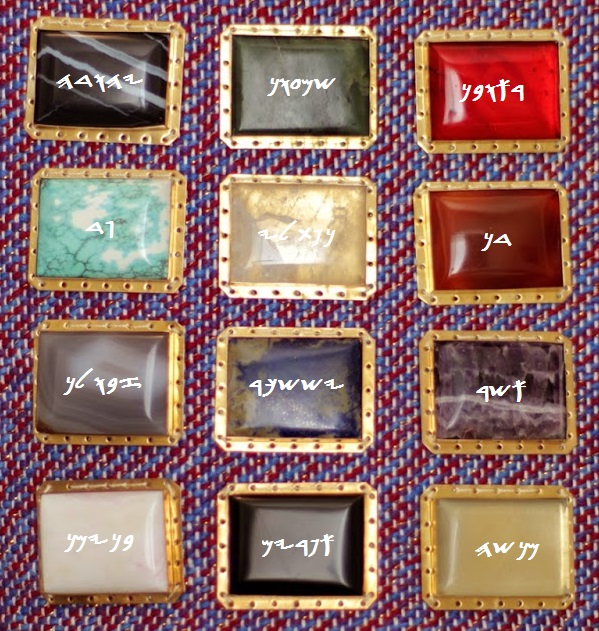
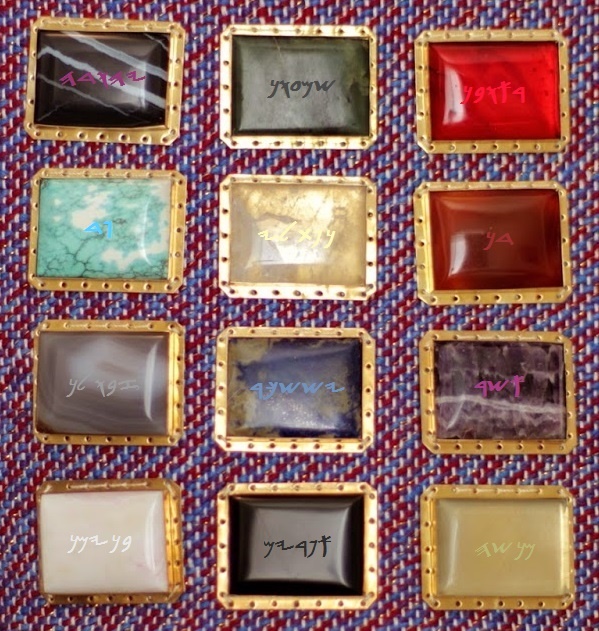
This is the third order possibility of the order of the twelve Sons of Israel that is the same as the second possible but switching plances between Benjamin with Manasseh and Ephraim
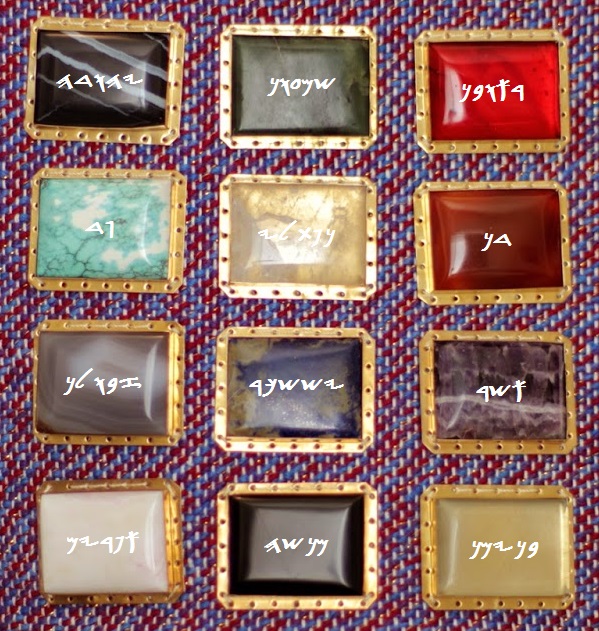
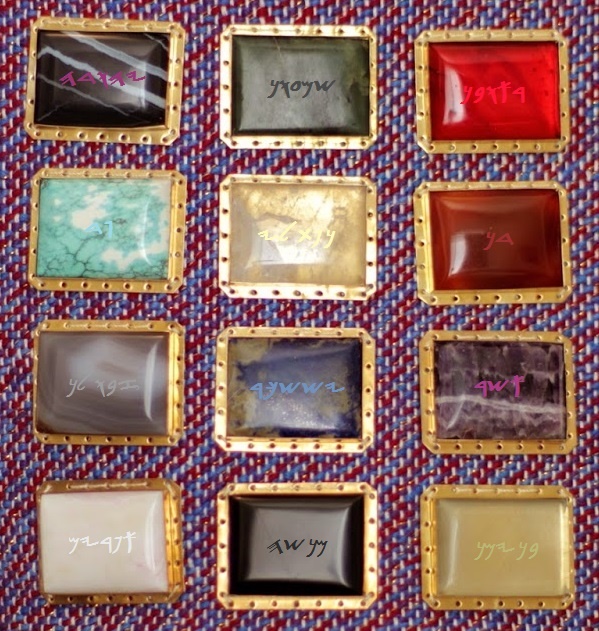
Looking at the words:
LINEN (SIX STRINGED LINEN, SIX BLEACHED LINEN, BLEACHED LINEN, WHITE LINEN)
The Hebrew word for interwoven (embroidered, inchased) is "shah-vahts"- Shin, Bet, Tsade Sophit (Ubs) It is from Strong's Concordance number 7660, and its definition
A primitive root; to interweave (colored) threads in squares; by implication (of reticulation) to inchase gems in gold: - embroider, set.
This Hebrew word is mentioned only two times in the entire Tanakh, and they are both noted in this week's Torah portion chapter in verses twenty and thirty nine.
Verses twenty two through twenty nine
22 And you shall do (make) upon the Pocket (Breast Pocket) of Chains at the borders (boundaries) of a doing (work) of Cords (Wreaths, Ropes) of pure gold. 23 And you shall do (make) upon the Pocket (Breast Pocket) two Rings of gold, and you shall give ta-the two Rings upon the two ends (edges) of the Pocket (Breast Pocket). 24 And you shall give ta-the two Cords (Wreaths) of the gold upon the two Rings to the ends (edges) of the Pocket (Breast Pocket). 25 And ta-the two ends (edges) of the two Cords (Wreaths, Ropes) you shall give upon the two Broaches (Brocades, Ouches), and give them upon the Upper Arm Corners (Shoulders) of the Ephod to before (the front of) his face. 26 And you shall do (make) two Rings of gold, and you shall set (put) them upon the two ends (edges) of the Pocket (Breast Pocket) upon his lip (edge) which is to over the Ephod housingward (inward). 27 And you shall do (make) two Rings of gold, and you shall give them upon the two Upper Arm Corners (Shoulders) of the Ephod from below (beneath), before (at the front of) his face, by associating (being along with, societizing, huddling together) his joining (juncture), from above (upon) the Belt (Band) of the Ephod. 28 And they shall bind ta-the Pocket (Breast Pocket) with his Rings to the Rings of the Ephod on a string (ribbon) of blue to be above (upon) the Belt (Band) of the Ephod, and the Pocket (Breast Pocket) shall not be loosed (displaced) from upon the Ephod. 29 And Aaron shall bear (carry, lift up) ta-the names of the Sons of Israel on the Pocket (Breast Pocket) of the Judgment (Ordinance) over (upon) his heart, in his going to the Sacred Area (Holy Area), for a Remembrance (Memorial) to the Face of hwhy continually.
THE SYMBOLIC MEANINGS OF THE CHAINS OF CORDS (WREATHS) AND RINGS
Gold: Kingdom, Eternal, Perfection
GENDER:
Chains of Cords (Wreaths): FEMALE
Rings: FEMALE
Looking at the account, it reveals to us that there are "six" rings made, all attached to the Breast Pocket:
FIRST TWO RINGS
23 And you shall do (make) upon the Pocket (Breast Pocket) two Rings of gold, and you shall give ta-the two Rings upon the two ends (edges) of the Pocket (Breast Pocket).
SECOND TWO RINGS
26 And you shall do (make) two Rings of gold, and you shall set (put) them upon the two ends (edges) of the Pocket (Breast Pocket) upon his lip (edge) which is to over the Ephod housingward (inward).
THIRD TWO RINGS
27 And you shall do (make) two Rings of gold, and you shall give them upon the two Upper Arm Corners (Shoulders) of the Ephod from below (beneath), before (at the front of) his face, by associating (being along with, societizing, huddling together) his joining (juncture), from above (upon) the Belt (Band) of the Ephod.
There are various kinds of High Priest Garments made, but I have yet to find one that provides the best example what these items would look like and how they are put together.
The six rings can be compared to the Chrubims' six wings, which is noted in the book of the prophet Isaiah, and the apostle John's book of Revelation
Isaiah 6:1 In the year that king Uzziah died I saw also ta-Adonai sitting upon a throne, high and lifted up, and His Train filled ta-the Temple. 2 From upon to Him stood the seraphims: six wings, six wings; to one on twain, covered His Face, and on twain, covered His Feet, and on twain, flew. 3 And one cried unto another, and said, Holy, holy, holy, is hwhy of Armies (Hosts): the whole earth is full of His Glory.
Revelation 4:6 And before the throne there was a sea of glass like unto crystal: and in the midst of the throne, and round about the throne, were four beasts full of eyes before and behind. 7 And the first beast was like a lion, and the second beast like a calf, and the third beast had a face as a man, and the fourth beast was like a flying eagle. 8 And the four beasts had each of them six wings about him; and they were full of eyes within: and they rest not day and night, saying, Holy, holy, holy, hwhy El Shaddai, Who Was, and Is, and Is to Come.
Verse thirty
THE URIM AND THE THUMMIM
30 And you shall give to the Pocket (Breast Pocket) of the Judgment (Ordinance) ta-the Urim and ta-the Thummim; and they shall be over (upon) the heart of Aaron in his going (entering) to the Face of hwhy: and Aaron shall bear (carry, lift up) ta-the Judgment (Ordinance) of the Sons of Israel over (upon) his heart to the Face of hwhy continually.
THE SYMBOLIC MEANINGS OF URIM AND THUMMIM
Stones: Purity
GENDER:
Urim and Thummim Stones: MALE(?)
It is commonly accepted that the two stones were black and white: black for the Thummim, and white for the Urim. It is supposed that the white Urim stone would be common for positive results, like "yes", "innocent", etc., and the black Thummim stone would be for negative results, like "no", "guilty", etc. There is no mention that the names of the Urim and the Thummim are etched on, which tells me that the stones are not to be etched.
Another issue is that I have seen images of one stone in one shape while the other stone is in a similar shape, but different, or in a different shape entirely. This is not the case, because if they were different shapes, the High Priest could manipulate the answer. The two stones have to be the exact same size, shape and smoothness, so that there would be no manipulation in the process.
Looking at the following words:
URIM
The Hebrew word for Urim is "Oo-reem"-Aleph, Vav, Resh, Yod, Mem Sophit (Myrwa). It is from Strong's Concordance number 224, and its defintion
Plural of H217; lights; Urim, the oracular brilliancy of the figures in the high priest’s breastplate: - Urim.
from 217 "oor" (rwa), and its definition
From H215; flame, hence (in the plural) the East (as being the region of light): - fire, light. See also H224.
from 215 "ohr" (rwa), and its definition
A primitive root; to be (causatively make) luminous (literally and metaphorically): - X break of day, glorious, kindle, (be, en-, give, show) light (-en, -ened), set on fire, shine.
THUMMIM
The Hebrew word for Thummim is "too-meem"- Tav, Mem, Yod, Mem Sophit (Mymt). It is from Strong's Concordance number 8550, and its definition
Plural of H8537; perfections, that is, (technically) one of the epithets of the objects in the high priest’s breastplate as an emblem of complete Truth: - Thummim.
from 8537 "tohm" (mt), and its definition
From H8552; completeness; figuratively prosperity; usually (morally) innocence: - full, integrity, perfect (-ion), simplicity, upright (-ly, -ness), at a venture. See H8550.
from 8552 "tah-mahm" (Mmt), and its definition
A primitive root; to complete, in a good or a bad sense, literally or figuratively, transitively or intransitively: - accomplish, cease, be clean [pass-] ed, consume, have done, (come to an, make an) end, fail, come to the full, be all gone, X be all here, be (make) perfect, be spent, sum, be (shew self) upright, be wasted, whole.
There are not that many accounts regarding the use of the Urim and Thummim. One account is noted in the Torah portion of Pinkhas, in the book Numbers
Numbers 27:15 And Moses spoke to hwhy, to say, 16 hwhy, Elohim of the spirits of all flesh, shall visit (oversee) a man upon the Congregation 17 which shall go out to their faces, and the which shall enter to their faces, and the which shall have them go out, and the which shall have them enter; and the Congregation of hwhy, she shall not be as the flock which has not a shepherd to them. 18 And hwhy said to Moses, Take for you ta-Joshua, son of Nun, a man which has the Spirit in him, and you shall support (lay) ta-your hand upon (over) him; 19 And you shall have him stand to the face of Eleazar, the Priest, and to the face of all of the Congregation; and you shall command him to their eyes, 20 and you shall give your grandeur (majesty) upon (over) him, by that, all of the Congregation of the Sons of Israel, they will listen. 21 And shall stand to the face of Eleazar, the Priest, and shall inquire (ask) for him on the Judgment of the Urim to the Face of hwhy: upon his mouth they shall go out, and upon his mouth they shall enter, he and all of the Sons of Israel with him, and all of the Congregation.
Another account of the Urim is when King Saul looked to it before he went to the witch of Endor, which is noted in the book of the prophet Samuel
1 Samuel 28:6 And when Saul enquired of hwhy, hwhy answered him not, neither by dreams, nor by Urim, nor by prophets.
Notice the Thummim was not noted in these two accounts. In Joshua's account, it doesn't say what the Urim does when he inquires the High Priest. In king Saul's account, it doesn't say it either. Did the Urim stone glow when hwhy answers them if He responds? I don't know. The Scriptures don't say.
This is another account of the Urim and the Thummim, which is noted in the book of the prophet Nehemiah (Note: The book of Ezra says the same thing)
Nehemiah 7:1 Now it came to pass, when the wall was built, and I had set up the doors, and the porters and the singers and the Levites were appointed, 2 That I gave my brother ta-Hanani, and ta-Hananiah, the ruler of the palace, charge over Jerusalem: for he was a faithful man, and feared ta-the Elohim above many. 3 And I said unto them, Let not the Gates of Jerusalem be opened until the sun be hot; and while they stand by, let them shut the doors, and bar them: and appoint watches of the inhabitants of Jerusalem, every one in his watch, and every one to be over against his house. 4 Now the city was large and great: but the People were few therein, and the houses were not builded. 5 And my Elohim put into mine heart to gather together ta-the Nobles, and ta-the Rulers, and ta-the People, that they might be reckoned by genealogy. And I found a register of the genealogy of them which came up at the first, and found written therein,... 63 And of the Priests: the sons of Habaiah, the sons of Koz, the sons of Barzillai, which took one of the daughters of Barzillai, the Gileadite, to wife, and was called after their name. 64 These sought their register among those that were reckoned by genealogy, but it was not found: therefore were they, as polluted, put from the Priesthood. 65 And the Tirshatha said unto them, that they should not eat of the Most Holy Things, till there stood up a Priest with Urim and Thummim.
The Tirshatha was Nehemiah.
Another account of the Urim and Thummim is noted when Moses prophecies each of the tribes, which is noted in the Torah portion of V'zoth Ha-B'rakhah, in the book of Deuteronomy
Deuteronomy 33:8 And of Levi, said, Your Thummim and your Urim are for your Merciful (Saintly) Man whom you tested (tempted, tried, proved) him in Massah, you contended upon the waters of Meribah;
Notice that the first letter of each of the words of the Urim and the Thummim are "Aleph" (a) and "Tav" (t)- symbols for "the beginning" and "the end". These two stones are the hints of Yeshua as the Aleph and Tav (ta). Yeshua is the Aleph and Tav, which is noted in the apostle John's book of Revelation
Revelation 1:11 Saying, I am Alpha [Aleph] and Omega [Tav], the first and the last...
The Urim and the Thummim is Yeshua in the Deuteronomy passage above.
Also, it can be said that Yeshua as the Urim is symbolized as "the Light" of the world and "the Perfection" of overcoming sin and death in our lives.
These are other verses pertaining to Yeshua through His Lightness in the Tanakh and in the Brith Khadashah (the New Covenant)
Psalms 119:105 Thy Word is a Lamp unto my feet, and a Light unto my path.
Isaiah 2:5 O House of Jacob, come ye, and let us walk in the Light of hwhy.
John 1:4 In him [Yeshua] was Life; and the Life was the Light of men. 5 And the Light shineth in darkness; and the darkness comprehended it not.... 7 The same came for a witness, to bear witness of the Light, that all men through Him might believe. 8 He was not that Light, but was sent to bear witness of that Light. 9 That was the True Light, which lighteth every man that cometh into the world.
John 8:12 Then spake Yeshua again unto them, saying, I am the Light of the world: he that followeth Me shall not walk in darkness, but shall have the Light of Life.
John 9:5 As long as I am in the world, I am the Light of the world.
John 12:46 I am come a Light into the world, that whosoever believeth on Me should not abide in darkness.
These are some verses pertaining to hwhy's perfection, which is noted in various Brith Khadashah (New Covenant) sources
Matthew 5:48 Be ye therefore perfect, even as your Father which is in heaven is Perfect.
2 Corinthians 12:9 And he said unto me, My Grace is sufficient for thee: for My Strength is made Perfect in weakness....
Ephesians 4:13 Till we all come in the unity of the faith, and of the knowledge of the Son of Elohim, unto a perfect man, unto the measure of the stature of the fulness of Messiah:
Colossians 1:28 Whom we preach, warning every man, and teaching every man in all wisdom; that we may present every man perfect in Messiah Yeshua:
1 John 4:18 There is no fear in Love; but Perfect Love casteth out fear: because fear hath torment. He that feareth is not made perfect in Love.
These are just examples, mostly in the Brith Khadashah (the New Covenant) of Yeshua who is the Light and the Perfection.
These are image possibilities of the Urim and Thummim
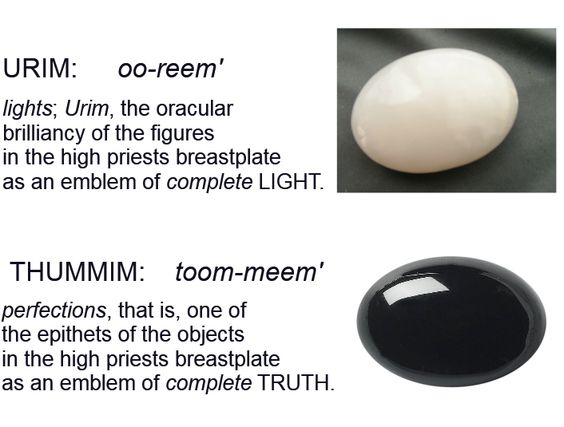
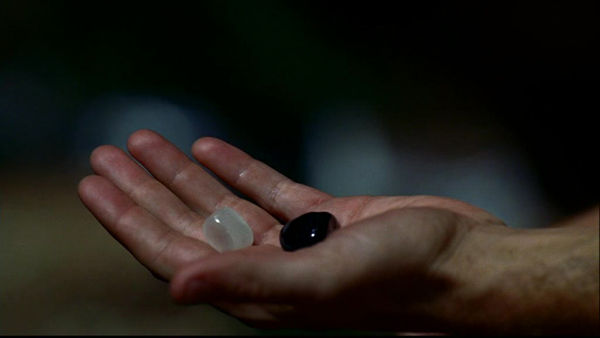
Verses thirty-one and thirty two
THE BLUE ROBE OF THE EPHOD
31 And you shall do (make) ta-the Outer Robe (Upper Robe) [(?Trespass Robe?, ?Transgressor Robe?)] of the Ephod wholly of blue. 32 And shall be the mouth of his head in his midst: a lip shall be to his mouth all around, a doing (work) of a braider (rugger, weaver) like the mouth of a habergeon (corselet, sleeveless coat, ?glow coat?, ?armored mail?) shall be to him. Shall not be rent.
THE SYMBOLIC MEANINGS OF THE BLUE ROBE OF THE EPHOD
Blue: Heaven
GENDER:
Robe: MALE
It is interesting that this garment is completely of one color, and it is blue. Not like the other garment that is mixed colors and gold. As noted above, the blue color represents Heaven as in the Kingdom of Heaven, showing that this is a "heavenly" matter.
Mark Moses of El Shaddai Ministries noted that young Samuel wore an Ephod, which is noted in his book
1 Samuel 2:18 But Samuel ministered ta-before hwhy, being a child, girded with a linen (flax) ephod.
Mark Biltz also noted that King David wore the Ephod, which is noted in the book of the Chronicles
1 Chronicles 15:27 And David was clothed with a robe of fine linen, and all the Levites that bare ta-the Ark, and the singers, and Chenaniah the master of the song with the singers: David also had upon him an ephod of linen (flax).
Based on these two accounts, the Blue Ephod could have been made of flax or linen.
This is an example of a pattern of the Blue Robe of the Ephod
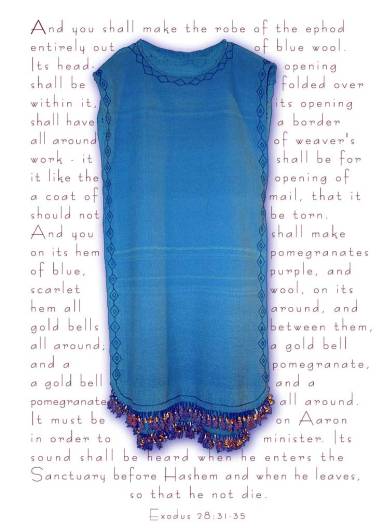
The "lip" and the "mouth" of the garment are a representations and symbols of the Word of hwhy being "spoken" forth through the "lips" and the "mouth" of the High Priest's garment.
This is a rough sketch of the mouth and lip of the blue robe
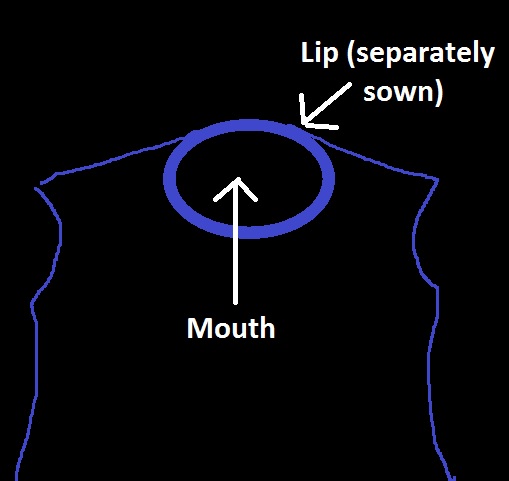
Based on this Blue Robe, if we take it at its word, this is the key garment that would nullify one as the High Priest, otherwise, hwhy would not have made a big deal about it to make it so that it would not rent. This is a key example regarding the High Priest's garment rent, which is noted in the Gospels of Matthew and Mark
Matthew 26:65 Then the High Priest rent his clothes, saying, He hath spoken blasphemy; what further need have we of witnesses? Behold, now ye have heard His blasphemy.
Mark 14:63 Then the High Priest rent his clothes, and saith, What need we any further witnesses?
This was Caiaphas, who was the current High Priest during Yeshua's time, until he rented his High Priest garment, then Yeshua took over the High Priesthood.
Also, when Caiaphas "rent" the garment, he did it at the "lip" and "mouth" of the garment. In other words, Caiaphas destroyed the lip and mouth that speaks the Word of hwhy, thus nullified the garments ability to "speak" the Word through the High Priest's garment. It is just as well that Caiaphas rented his "lip" and "mouth", because he was speaking against the Word of hwhy.
This is another scene of a garment without seam which occurred at Yeshua's crucifixion, which is noted in the Gospel of John
John 19:23 Then the soldiers, when they had crucified Yeshua, took His garments, and made four parts, to every soldier a part; and also His Coat: now the Coat was without seam, woven from the top throughout. 24 They said therefore among themselves, Let us not rend it, but cast lots for it, whose it shall be: that the scripture might be fulfilled, which saith, They parted my raiment among them, and for my vesture they did cast lots. These things therefore the soldiers did.
The scripture source in verse twenty four of John came from king David, which is noted in the book of Psalms
Psalm 22:18 They part my garments among them, and cast lots upon my vesture.
When Yeshua cried out "Eli! Eli! Lama aza-tani", He was crying out to read Psalm chapter twenty two, because things in this chapter were being fulfilled at the crucifixion like the parting of the garments in verse eighteen.
Yeshua's garment, now the High Priest garment, could not be rent, because that would mean the true Word of hwhy would not be spoken with all that Yeshua spoke. So the lip and mouth of the garment were kept in tact. This also shows us that Yeshua is "still" our "Eternal High Priest", which is noted in the apostle Paul's book of Hebrews
Hebrews 5:9 And being made Perfect, He became the Author of Eternal Salvation unto all them that obey Him; 10 Called of hwhy an High Priest after the order of Melchi-Tsedek.
!!!hwhy Kl bdk
No one else, even if they could prove that they are a direct descendant of Aaron, cannot be the High Priest, because that very garment was not torn. Anyone who tries, is "illegitimate", and cannot do the High Priestly acts on the Temple Mount in Jerusalem. Only Yeshua could do that.
Looking at the word WEAVER
The Hebrew word for weaver is "ah-rahg"- Aleph, Resh, Gimel (gra). It is from Strong's Concordance number 707, and its definition
A primitive root; to plait or weave: - weaver (-r).
This is where we get our modern English word "rug".
Verses thirty three through thirty five
THE BELLS AND THE POMEGRANATES
33 And you shall do (make) upon his Hem Pomegranates of blue, and of purple, and of crimson (red) worm [(worm of crimson (red))] upon his Hem all around; and Round Bells of gold in their midst all around: 34 A Round Bell of gold and a Pomegranate, a Round Bell of gold and a Pomegranate upon the Hem of the Outer Robe (Upper Robe) [(?Trespass Robe?, ?Transgressor Robe?)] all around. 35 And shall be upon (over) Aaron for the Ministry [(for ministering)]: and his sound shall be heard in his entering to the Sacred Area (Sanctuary, Holy Area) to the Face of hwhy, and in his coming out (going out); and shall not die.
THE SYMBOLIC MEANINGS OF THE BELLS AND THE POMEGRANATES
Gold: Kingdom, Eternal, Perfection
Blue: Heaven
Purple: Royalty
Crimson worm: Blood, Atonement, Sacrifice
GENDER:
Bells: (MALE?)
Pomegranates: (MALE?)
Question: "Are the pomegranates each a mixture of all three different colored threads, or is it one pomegranate of blue, one pomegranate of purple and one pomegranate of crimson worm"? The way it was worded for the colors used for making the apron of the ephod and the breastplate of judgment, it is clear that the colors mentioned here in this week's Torah portion passage is the same as those for the apron and the breastplate. So it can be said that it means the three colors are to be mixed together in one pomegranate.
The bell that was made at the wilderness was probably not the typical bell we commonly see as a flared bell, but more like a round closed bell. The bells are not the typical bells we see in churches and cathedrals, but they are round. Also, I did not see this until this week's Torah portion, but these round bells were made to have a metal ball inside the round bell to make a jingle" sound, like "Jingle Bells" or typical "Sleigh Bells".
These are image examples of the pomegranates that go on the Blue Robe
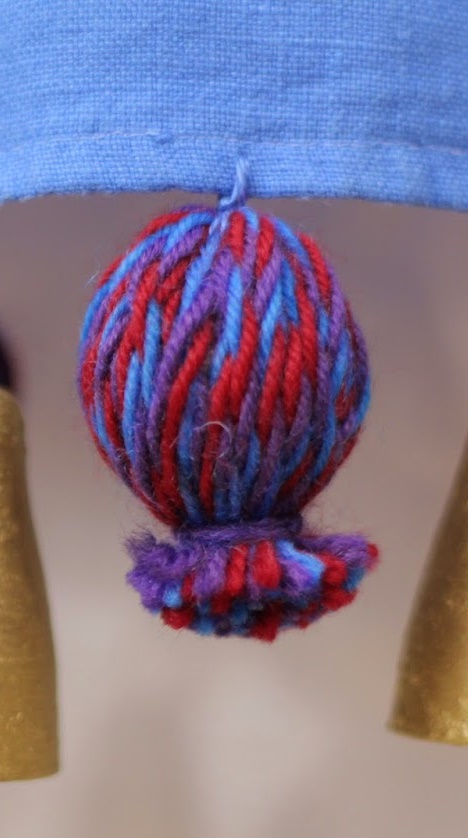
This is an image of golden sleigh bells, and could have been a possible pattern for the golden bells for the Robe
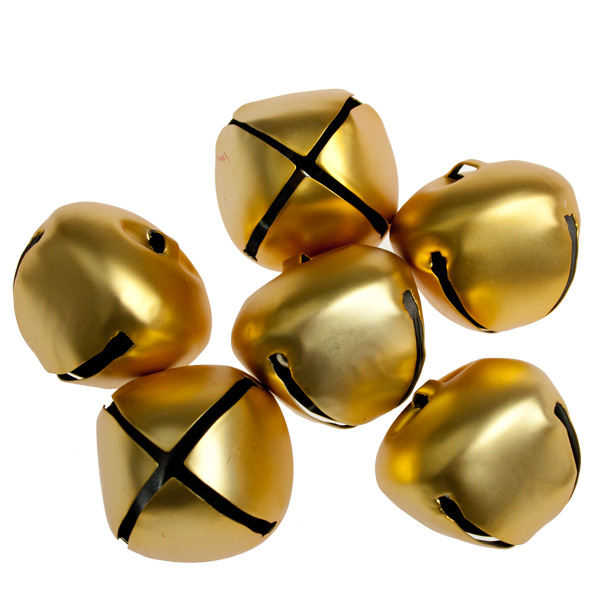
Looking at the word BELL
The Hebrew word for bell is "pah-ah-mohn"- Peh, Ayin, Mem, Nun Sophit (Nmep). It is from Strong's Concordance number 6472, and its definition
From H6471; a bell (as struck): - bell.
from 6471 "pah-ahm" (mep), and its definition
From H6470; a stroke, literally or figuratively (in various applications): - anvil, corner, foot (-step), going, [hundred-] fold, X now, (this) + once, order, rank, step, + thrice, [often-], second, this, two) time (-s), twice, wheel.
from 6470 "pah-ahm" (mep), and its definition
A primitive root; to tap, that is, beat regularly; hence (generally) to impel or agitate: - move, trouble.
Based on this information, this is where we get the modern French word "pomme", meaning apples. I wonder if we get the cheeleaders "pom poms" from it as well? Also, it is probable we get the modern English word "pummel" from this Hebrew word.
In verse thirty five of this week's Torah portion passage, it could be that the purpose of the bells is to know if the High Priest is still alive while he is in the Tabernacle. The question is, if the High Priest dies, how do they take him out? There are those that say they have a rope attached to him. That is not so. There is no proof of that. It is most likely that the Priests took out the High Priest like the same was as they did in taking Nadab and Abihu out of the Tabernacle by hand, which is noted in the Torah portion of Sh'mini, in the book of Leviticus
Leviticus 10:1 And Nadab and the Abihu, the sons of Aaron, they took a man his censer, and they gave fire in them, and they set incense upon her, and they brought near a strange fire to the Face of hwhy which was not commanded them. 2 And a fire, she went out from of the Face of hwhy, and she consumed them, and they died to the Face of hwhy. 3 And Moses said to Aaron, He is which hwhy spoke, to say, In coming near (drawing near) Me I will be sanctified [(In My coming near (drawing near) will I be sanctified)], and upon the face of all of the People I will [(will I)] be glorified. And Aaron was silent. 4 And Moses called to Mishael and to Elzaphan, sons of Uzziel, uncle of Aaron, and said to them, Come near (draw near), carry (bear, pick up) ta-your brothers from ta the face of the Sanctuary to from outside by the Camp.
It was Elizaphan that lead the Kohathites to handle the Tent's furniture: the Menorah, etc.
This shows us that a non-Aaronite Priest, in this case, Aaron's cousins, were allowed to take out priests from the Sanctuary in the Tent. No cords required.
These bells are probably used for the activities of the High Priest in his rehearsals to hwhy.
Verses thirty six through thirty eight
THE HEAD PIECE
36 And you shall do (make) a Plate of pure gold, and you shall engrave (carve, sculpt) upon him, an engraving (carving, sculpting) of a signet (seal ring), SACREDNESS (SACRED, HOLINESS, HOLY) TO YAHWAH. 37 And you shall set (put) him upon a thread of blue, and shall be upon (over) the Turban (Miter); shall be to before (at the front of) the face of the Turban (Miter). 38 And shall be upon the forehead of Aaron, and Aaron shall bear (carry, lift up) ta-the Iniquity of the Sacred Things (Holy Things) which the Sons of Israel, they shall sanctify to all of their Sacred (Holy) Gifts; and shall be upon his forehead continually for acceptance (delight) for them to the Face of hwhy.
THE SYMBOLIC MEANINGS OF THE HEAD PIECE
Gold: Kingdom, Eternal, Perfection
Blue: Heaven
GENDER:
Plate: MALE
Turban (Miter): FEMALE(?)
Overall, this is the Crown of the High Priest, like a crown for a king.
In verse thirty seven in the Hebrew text, the Hebrew for the phrase thread of blue is "p'theel t'kheyleth" (tlkt lytp)
Looking at the folloing words:
PLATE
The Hebrew word for plate is "tseets"- Tsade, Yod, Tsade (uyu). It is from Strong's Concordance number 6731, and its definition
From H6692; properly glistening, that is, a burnished plate; also a flower (as bright colored); a wing (as gleaming in the air): - blossom, flower, plate, wing.
from 6692 "tsoots" (uwu), and its definition
A primitive root; to twinkle, that is, glance; by analogy to blossom (figuratively flourish): - bloom, blossom, flourish, shew self.
THREAD
The Hebrew word for thread is "p'theel"- Peh, Tav, Yod, Lamed (lytp). It is from Strong's Concordance number 6616, and its defintion
From H6617; twine: - bound, bracelet, lace, line, ribband, thread, wire.
from 6617 "pah-thahl" (ltp), and its definition
A primitive root; to twine, that is, (literally) to struggle or (figuratively) be (morally) tortuous: - (shew self) froward, shew self unsavoury, wrestle.
BLUE
The Hebrew word for blue is "t'khey-leth"- Tav, Kaph, Lamed, Tav (tlkt). It is from Strong's Concordance number 8504, and its defintion
Probably for H7827; the cerulean mussel, that is, the color (violet) obtained therefrom or stuff dyed therewith: - blue.
from 7827 "sh'key-leth" (tlks), and it definition
Apparently from the same as H7826 through some obscure idea, perhaps that of peeling off by concussion of sound; a scale or shell, that is, the aromatic mussel: - onycha.
from 7826 "shah-khahl" (lks), and its definition
From an unused root probably meaning to roar; a lion (from his characteristic roar): - (fierce) lion. [or roar of a sound of a shell]
This could be where we get our modern English word "shell" as in sea shell.
These three Hebrew words were used in a different Commandment, which is noted in the Torah portion of Sh'lakh L'kha, in the book of Numbers
Numbers 15:37 And hwhy spoke to Moses, to say, 38 Speak to the Sons of Israel, and you shall say to them: and they shall do (make) for themselves tassels (fringes) upon the corners (wings) of their garments for their generations, and they shall give upon the tassels (fringes) (tuyu) of the corners (wings) a thread of blue (tlkt lytp): 39 And shall be to you for a tassel (fringe), and you shall look upon him, and you shall remember ta-all of the Commandments of hwhy, and you shall do them; and you shall not search (tour) after your hearts and after your eyes which you go whoring (fornicate) after them: 40 By that you shall remember, and you shall do ta-all of My Commandments, and you shall be Sacred Ones (Holy Ones) to your Elohim. 41 I am hwhy, your Elohim, which I brought you out from the land of Egypt, to be to you for Elohim: I am hwhy, your Elohim.
Looking at the word TASSELS
The Hebrew word for tassels is "tsee-tseeth"- Tsade, Yod, Tsade, Tav (tuyu). It is from Strong's Concordance number 6734, and its defintion
Feminine of H6731; a floral or wing like projection, that is, a fore lock of hair, a tassel: - fringe, lock.
This word is noted above. And the phrase ribbon of blue are the Hebrew words "p'theel t'kheyleth" (tlkt lytp)- the same three words used in this Torah passage in Exodus 28:37.
Question: "Is there a connection between these two commandments"? If there is, it would be that the High Priest wearing a gold tsits plate and a blue ribbon is the High Priest's version of bearing the Commandments of hwhy on his head, as compared to the Sons of Israel wearing tsitstits of blue ribbons to "remember" the Commandments of hwhy. (I guess this was the Israelites' consolation for not being Priests :) )
The writing on the gold plate would have been in Paleo-Hebew. This is one rough way it could have looked like in Moses and Aaron's day

This is a possible pattern of the High Priest Head Piece with all of the items
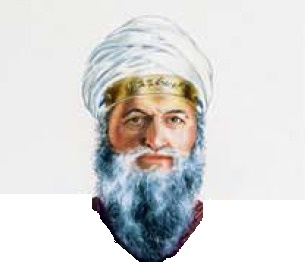
Verse thirty nine
THE EMROIDERED COAT (TUNIC)
39 And you shall interweave (embroider, inchase) the Coat (Tunic) of linen (six-bleached linen, bleached linen, white linen), and you shall do (make) the Turban (Miter) of twisted (twined, fine) linen (six stringed linen, six bleached linen, bleached linen, white linen), and you shall do (make) the Girdle of a doing (work) of a needler (fabricator, texturer, cunning work).
THE SYMBOLIC MEANINGS OF THE EMBROIDERED COAT
Fine linen: Righteousness (source: maranathalife.com)
GENDER:
Coat (Tunic): (FEMALE?)
Turban (Miter): (FEMALE?)
Girdle: (MALE?)
This is a possible sketch of the High Priest Embroidered Coat
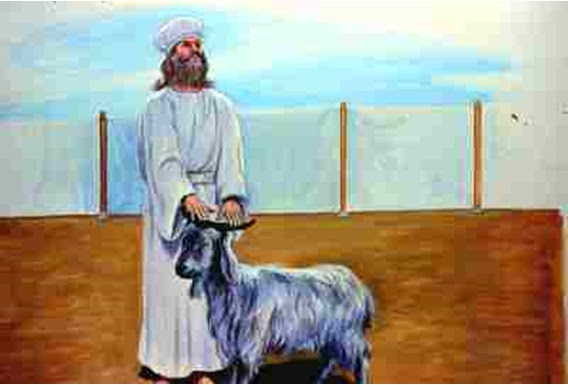
Verses forty and forty-one
THE COATS, GIRDLES AND BONNETS
40 And for the sons of Aaron, you shall do (make) Coats (Tunics), and you shall do (make) for them Girdles, and you shall do (make) for them Bonnets for glory and for ornamentalness (gleamness, beauty). 41 And you shall clothe them, ta-Aaron your brother, and ta-his sons with him; and you shall anoint them, and you shall fill (consecrate) ta-their hands, and you shall sanctify them, and they shall do the Priestship (Priestly Acts) to Me.
THE SYMBOLIC MEANINGS OF THE COATS, GIRDLES AND BONNETS
Fine linen: Righteousness (source: maranathalife.com)
GENDER:
Coat (Tunic): (FEMALE?)
Turban (Miter): (FEMALE?)
Girdle: (MALE?)
When Solomon's Temple was dedicated, this is what king Solomon said, which is noted in the book of the Chronicles
2 Chronicles 6:41 Now therefore arise, hwhy Elohim, into Thy Resting Place, Thou, and the Ark of Thy Strength: let Thy Priests, hwhy Elohim, be clothed with Salvation, and let Thy Saints rejoice in goodness.
We in Yeshua- "Salvation"- have also become hwhy 's Priests, as noted earlier in the book of Revelation and in the epistle of Peter.
These are possible patterns of the Priests' Coats, Girdles and Bonnets
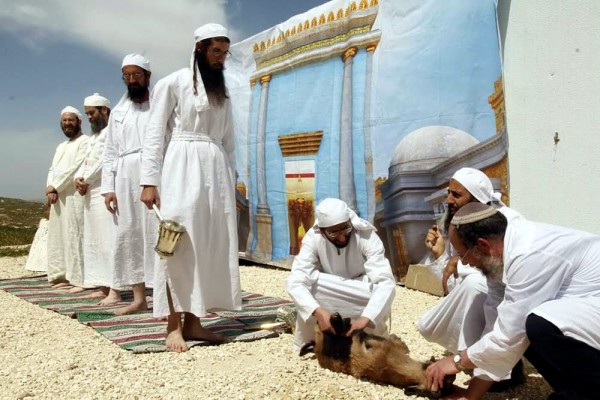
Verses forty two and forty three
THE BREECHES
42 And shall do (make) for them Breeches of bahd-linen (flax) to cover (conceal) the flesh of the nakedness; they shall be from their waist (loins) and unto their thighs (testacles): 43 And they shall be upon Aaron and upon his sons in their entering (going) to the Tent of Appointment, or in their approaching to the Altar to minister in the Sacred Area (Holy Area); and they shall not bear (carry, lift up) iniquity, and they shall have the death [(and they would die)]: A Statute of Ages to him and to his seed after him.
THE SYMBOLIC MEANINGS OF THE BREECHES
Fine linen: Righteousness (source: maranathalife.com)
GENDER:
Breeches: (MALE?)
These are elongated underpants.
Looking at the word BAHD-LINEN (FLAX)
The Hebrew word for bahd-linen (flax) is "bahd"- Bet, Dalet (db). It is from Strong's Concordance number 906, and its definition
Perhaps from H909 (in the sense of divided fibres); flaxen thread or yarn; hence a linen garment: - linen.
rom 909 "bah-dahd" (ddb), and its definition
A primitive root; to divide, that is, (reflexively) be solitary: - alone.
This is where we get our modern English word "body". Linen is also known as flax, and flax is a plant material. This Hebrew word is the only time used for material for the Priest's garments. It is probably symbolic that man's "foundations" came from the ground.
Notice in verse forty three of this week's Torah portion passage that it says it is to be Statute unto his seed, but it did not say his sons. Why did hwhy say it this way? He could have said sons, but hwhy was empasizing that it was referring to Aaron's seed.
These are images of possible patterns of the Breeches
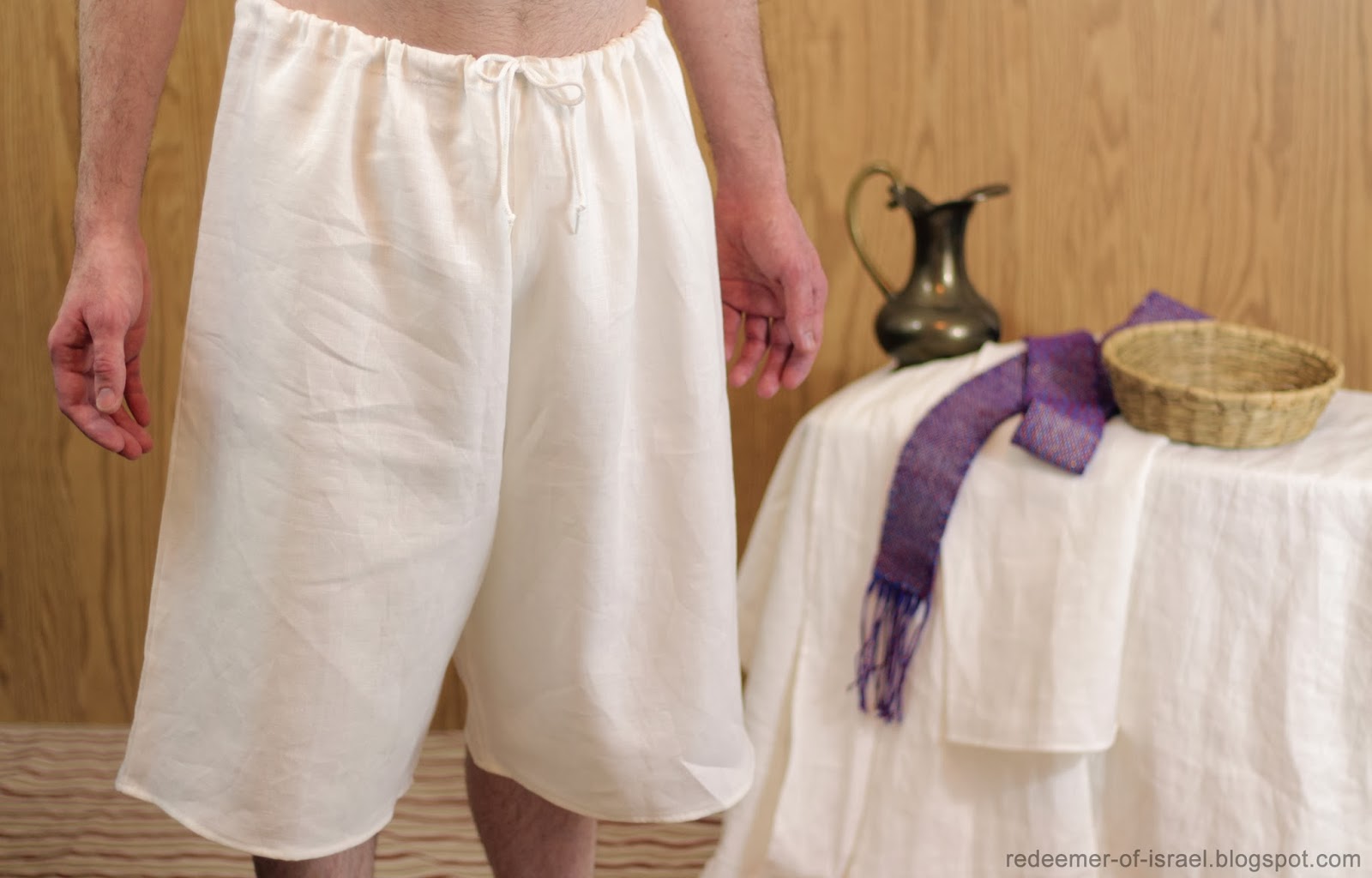
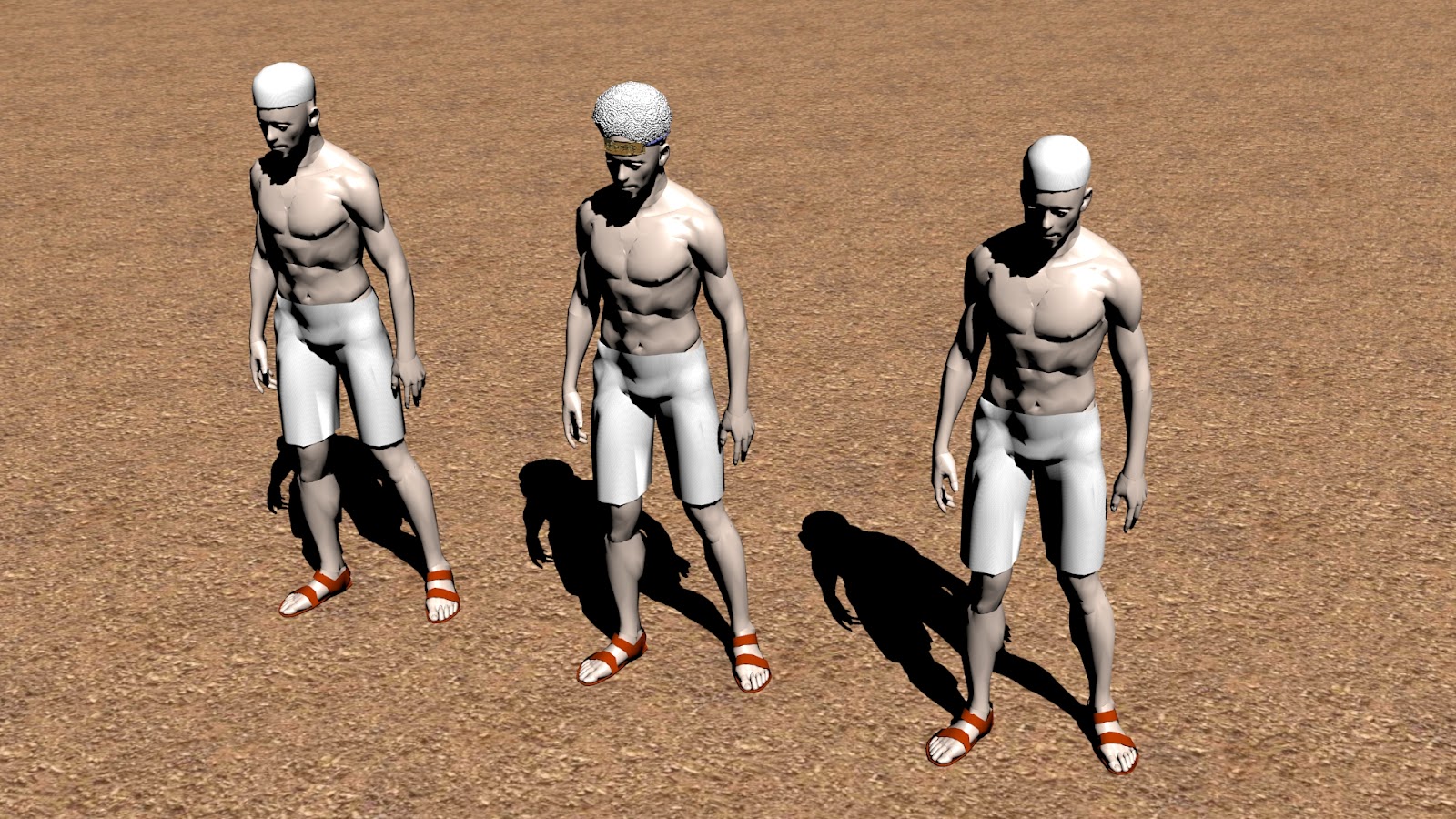
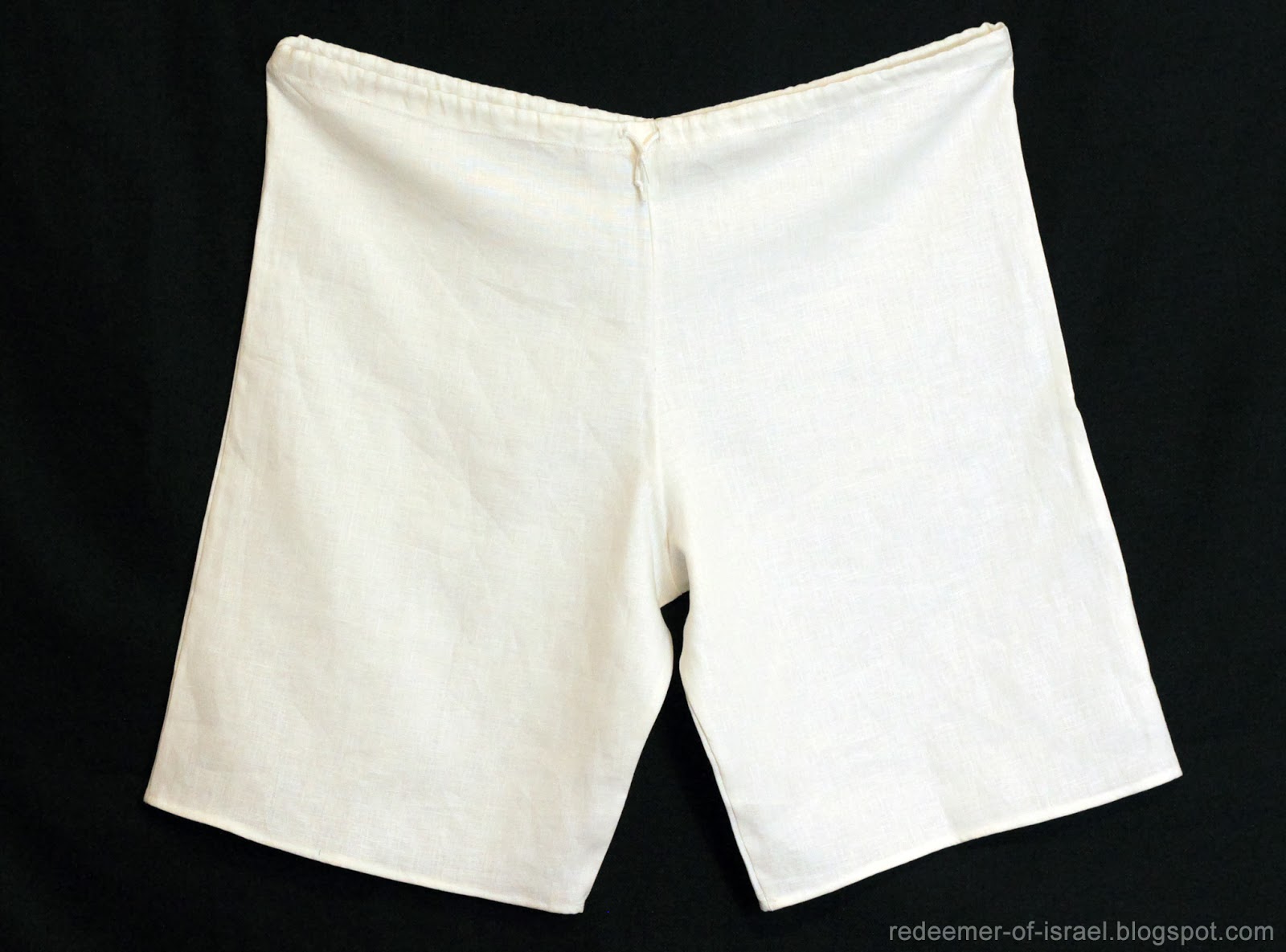
CHAPTER 29
Exodus 29:1-46
Exo 29:1 And this is the Word which you shall do unto them to sanctify them to the Priestship (to do Priestly Acts) to Me: Take one bullock, son of a herd, and two perfect rams, 2 And unleavened bread, and unleavened challah cakes overflowed (mixed) in the oil, and unleavened thin cakes (wafers) anointed in the oil: flour of wheat you shall do (make) them. 3 And you shall give them upon one twig basket (willow twig basket), and you shall bring them near in the twig basket (willow twig basket), and ta-the bullock, and ta the two rams.
4 And you shall bring near ta-Aaron and ta-his sons to the Entrance of the Tent of Appointment, and you shall wash them in the water. 5 And you shall take ta-the Garments, and and you shall clothe Aaron ta-the Coat (Tunic), and ta-the Outer Robe (Upper Robe) [(?Trespass Robe?, ?Transgressor Robe?)] of the Ephod, and ta-the Ephod, and ta-the Pocket (Breast Pocket), and you shall bind to him on the Belt (Band) of the Ephod: 6 And you shall put (set) the Turban (Miter) upon his head, and you shall give ta-the Sacred (Holy) Crown upon the Turban (Miter). 7 And you shall take ta-the Oil of the Anointing, and you shall pour (make soak) over (upon) his head, and you shall anoint him. 8 And you shall bring near ta-his sons, and you shall clothe them of Coats (Tunics). 9 And you shall gird them of Girdles, Aaron and his sons; and you shall wrap the Bonnets for them: and the Priestship (Priestly Office) shall be for them for a Statute of Ages: and you shall fill (consecrate) the hand of Aaron and the hand of his sons.
10 And you shall bring near ta-the bullock to the face of the Tent of Appointment: and Aaron and his sons shall support (lay) ta-their hands upon (over) the head of the bullock. 11 And you shall slaughter ta-the bullock (calf) to the Face of hwhy at the Entrance of the Tent of Appointment. 12 And you shall take from the blood of the bullock, and you shall give upon (over) the Horns of the Altar among your finger, and you shall shed (pour, spill out) ta-all of the blood to the Base (Foundation, Settled Area) of the Altar. 13 And you shall take ta-all of the kheylev-fat that covers (conceals) ta-the nearing areas, (nearness, inwards), and ta-the flap (caul, lobe) upon (over) the liver, and ta the two kidneys, and ta-the kheylev-fat that is upon (over) them, and you shall incense (smoke, fumigate, burn) to the Altar. 14 And ta-the flesh of the bullock, and ta-his skin, and ta-his dung, you shall burn up on the fire from outside by the Camp: He is a Sin Offering.
15 And you shall take ta-the one ram; and Aaron and his sons, they shall support (lay) ta-their hands upon (over) the head of the ram. 16 And you shall slaughter ta-the ram, and you shall take ta-his blood, and you shall strew (sprinkle) upon (over) the Altar all around. 17 And you shall dismember ta-the ram by his fragments (pieces, parts), and you shall wash his nearing areas (nearness, inwards), and his shoulder legs (lower shoulder legs), and you shall give upon (over) his fagments (pieces, parts), and upon (over) his head. 18 And you shall incense (smoke, fumigate, burn) ta-all of the ram at the Altar: He is an Elevation Offering (Ascension Offering, Burnt Offering) to hwhy: a pleasant scent, he is a Fire Offering to hwhy.
19 And you shall take ta the second ram; and Aaron and his sons shall support (lay) ta-their hands upon (over) the head of the ram. 20 And you shall slaughter ta-the ram, and you shall take from his blood, and shall give upon the tip (lobe) of the ear of Aaron, and upon the tip (lobe) of the ear of his sons, at the right, and upon the thumb of their right hand, and upon the thumb (toe) of their right foot, and you shall strew (sprinkle) ta-the blood upon (over) the Altar all around.
21 And you shall take from the blood which is upon (over) the Altar and from the Oil of the Anointing, and you shall spurt (besprinkle in expiation, sprinkle) upon (over) Aaron and upon (over) his Garments, and upon (over) his sons and upon (over) the Garments of his sons with him: and he shall be Sacred (Holy), and his Garments, and his sons, and the Garments of his sons with him.
22 And you shall take from the ram the kheylev-fat, and the tail fat, and ta-the kheylev-fat that covers (conceals) ta-the nearing areas (nearness, inwards), and ta the flap (caul, lobe) of the liver, and ta the two kidneys, and ta-the keylev-fat which is upon (over) them, and ta the right hip leg; for he is a Ram of Consecration (Fulfillment):
23 And one round loaf of bread, and one challah cake of bread of oil, and one thin cake (wafer) from the twig basket (willow twig basket) of the unleavened which is to the Face of hwhy: 24 And you shall put (set) the allness upon (over) the palms of Aaron, and upon (over) the palms of his sons; and you shall wave them of a Wave Offering to the Face of hwhy. 25 And you shall take them from their hands, and you shall make incense (smoke, fumigate, burn) to the Altar upon the Elevation Offering (Ascension Offering, Burnt Offering), for a pleasant scent to the Face of hwhy: He is a Fire Offering to hwhy.
26 And you shall take ta-the breast from the Ram of the Consecration (Fulfillment) which is for (belongs to) Aaron, and you shall wave him for a Wave Offering to the Face of hwhy: and shall be to you for rationing (sharing, a portion, allotment). 27 And you shall sanctify ta the breast of the Wave Offering, and ta the hip leg of the Heave Offering (Raise Offering) which is waved and the which is heaved up (raised up) from the Ram of the Consecration (Fulfillment) from which shall be for [(belong to)] Aaron and from which shall be for [(belong to)] his sons: 28 And shall be for [(belong to)] Aaron and for (to) his sons for a Statute of Ages from ta the Sons of Israel: for he is a Heave Offering (Raise Offering): and shall be a Heave Offering (Raise Offering) from ta the Sons of Israel from the Sacrifices of their Peace Offerings, of their Heave Offerings (Raise Offerings) to hwhy.
29 And the Sacred (Holy) Garments which shall be for [(belong to)] Aaron shall be for [(belong to)] his sons after him to be anointed in them, and to (for) fill (filling, consecrate, consecrating) ta-their hands in them. 30 And the Priest at his stead from his sons shall clothe them seven days which shall enter (go) to the Tent of Appointment to minister in the Sacred Area (Sanctuary, Holy Area).
31 And you shall take ta-the Ram of the Consecration (Fulfillment), and you shall boil ta-his flesh in the Sacred (Holy) Place. 32 And Aaron and his sons shall eat ta-the flesh of the ram and ta-the bread which is in the twig basket (willow twig basket) at the Entrance of the Tent of Appointment. 33 And they shall eat them which the Atonement is in them to consecrate (fill) ta-their hand to sanctify them: and a stranger shall not eat, for they are Sacred (Holy). 34 And if shall yether-remain (be remnant, be left) from the flesh of the Consecration (Fulfillment), and from the bread until the breaking period (morning), and you shall burn up ta-the yether-remainder (remnant, leftover) in the fire: shall not be eaten, for he is Sacred (Holy).
35 And you shall do to Aaron and to his sons, as the thus, according to [(as)] all which I have commanded you: You shall fill (consecrate) their hand seven days, 36 and you shall do (offer) a bullock for a Sin Offering for the day upon (over) the Atonements: and you shall purify (cleanse) upon (over) the Altar, in your Atonement upon (over) him, and you shall anoint him to sanctify him. 37 Seven days you shall atone upon (over) the Altar, and you shall sanctify him; and shall be the Altar of a Sacred (Holy) of Sacreds (Holies) [(Sacred of Sacreds, Holy of Holies)]: of anything that touches on the Altar shall be Sacred (Holy).
38 And this is which you shall do (offer) upon (over) the Altar; two sheep, sons of a year, by (for) the day, continually. 39 ta-the one sheep you shall do (offer) in the breaking period (morning); and ta the second sheep you shall do (offer) between the mixing periods (evenings): 40 And a tenth of flour overflowed (mixed) in the oil, a fourth of the hin, beaten; and a Drink Offering (Libation Offering) of a fourth of the hin of wine shall be for the one sheep. 41 And ta the second sheep you shall do (offer) between the mixing periods (evenings), and you shall do to her as (like) the Donation Offering (Tribute Offering, Food Offering, Grain Offering, Apportion Offering) of the breaking period (morning) and as (like) her Drink Offering (Libation Offering), for a pleasant scent of a Fire Offering to hwhy, 42 a Continual Elevation Offering (Ascension Offering, Burnt Offering) for your generations at the Entrance of the Tent of Appointment to the Face of hwhy which I will appoint to you there to speak to you there. 43 And I will appoint there to the Sons of Israel and shall be sanctified in My Glory. 44 And I will sanctify ta-the Tent of Appointment, and ta-the Altar: And I will sanctify ta-Aaron and ta-his sons for the Priestship (to do Priestly Acts) to Me. 45 And I will tabernacle in the midst of the Sons of Israel, and I will be to them for Elohim. 46 And they shall know for I am hwhy, their Elohim, which brought them out from the land of Egypt to tabernacle Myself in their midst: I am hwhy, their Elohim.
(NOTE: Not all verses will have comments)
Verses one through three
1 And this is the Word which you shall do unto them to sanctify them to the Priestship (to do Priestly Acts) to Me: Take one bullock, son of a herd, and two perfect rams, 2 And unleavened bread, and unleavened challah cakes overflowed (mixed) in the oil, and unleavened thin cakes (wafers) anointed in the oil: flour of wheat you shall do (make) them. 3 And you shall give them upon one twig basket (willow twig basket), and you shall bring them near in the twig basket (willow twig basket), and ta-the bullock, and ta the two rams.
The first thing Aaron and his sons did was to bring their sacrificial offering items as part of the precursor before they begin their Priestly Acts.
Looking at the following words:
CHALLAH CAKE
The Hebrew word for challah cake is "khah-lah"- Khet, Lamed, Heh (hlx). It is from Strong's Concordance number 2471, and it definition
From H2490; a cake (as usually punctured): - cake.
from 2490 "khah-ahl" (llx), and its definition
A primitive root (compare H2470); properly to bore, that is, (by implication) to wound, to dissolve; figuratively to profane (a person, place or thing), to break (one’s word), to begin (as if by an opening-wedge); denominatively (from H2485) to play (the flute): - begin (X men began), defile, X break, defile, X eat (as common things), X first, X gather the grape thereof, X take inheritance, pipe, player on instruments, pollute, (cast as) profane (self), prostitute, slay (slain), sorrow, stain, wound.
THIN CAKE (WAFER)
The Hebrew word for thin cake (wafer) is "rah-keek"- Resh, Kuph, Yod, Kuph (qyqr). It is from Strong's Concordance number 7550, and it definition
From H7556 in its original sense; a thin cake: - cake, wafer.
from 7556 "rah-kahk" (qqr), and its definition
A primitive root; to spit: - spit.
The key words to me from these two words are "defile", "wound", and "spit". This tells me that these types of cakes symbolizes Yeshua being defiled and wounded by being crucified by the cat of nine tails and taking on our defilements, as well as when Yeshua was being spat by the Roman soldiers during His crucification process.
!!!hwhy Kl dbk
Notice that this Hebrew word is the same root word that translates "profane", "defile", "pollute" and "wound". To me, this is an act of showing that the High Priest and the priests are taking on our defilements through eating this challah cake. This is the same with us as following believers in Yeshua that Yeshua, our Messiah, has taken our profanities and defilements and nailed them on the cross, because he has become the symbolic Challah Bread of His Flesh and took them to the cross and died for us.
!!!hwhy Kl dbk
Verses four through six
AARON, THE HIGH PRIEST
4 And you shall bring near ta-Aaron and ta-his sons to the Entrance of the Tent of Appointment, and you shall wash them in the water. 5 And you shall take ta-the Garments, and and you shall clothe Aaron ta-the Coat (Tunic), and ta-the Outer Robe (Upper Robe) [(?Trespass Robe?, ?Transgressor Robe?)] of the Ephod, and ta-the Ephod, and ta-the Pocket (Breast Pocket), and you shall bind to him on the Belt (Band) of the Ephod: 6 And you shall put (set) the Turban (Miter) upon his head, and you shall give ta-the Sacred (Holy) Crown upon the Turban (Miter). 7 And you shall take ta-the Oil of the Anointing, and you shall pour (make soak) over (upon) his head, and you shall anoint him. 8 And you shall bring near ta-his sons, and you shall clothe them of Coats (Tunics). 9 And you shall gird them of Girdles, Aaron and his sons; and you shall wrap the Bonnets for them: and the Priestship (Priestly Office) shall be for them for a Statute of Ages: and you shall fill (consecrate) the hand of Aaron and the hand of his sons.
This is like the Queen Elizabeth's British royal inauguration ceremony in 1952. They put on her royal garments, and after the last item, the royal crown, is placed on her head, then everyone shouts out "God save the Queen" three times. This is the precursor before Elizabeth II commenced her royal duties, like the protocol of the Priests, but the difference is that they would be bringing sacrifices to hwhy as the second step after they were dressed.
Looking at the following words:
OUTER ROBE (UPPER ROBE, {(?TRESSPASS ROBE?, ?TRANSGRESSOR ROBE?)]
The Hebrew word for Outer Robe (Upper Robe) [(?Trespass Robe?, ?Transgressor Robe?)] is "m'eel"- Mem, Ayin, Yod, Lamed (lyem). It is from Strong's Concordance number 4598, and it definition
From H4603 in the sense of covering; a robe (that is, upper and outer garment): - cloke, coat, mantle, robe.
from 4603 "mah-ahl" (lem), and its definition
A primitive root; properly to cover up; used only figuratively to act covertly, that is, treacherously: - transgress, (commit, do a) tresspass (-ing).
Notice that this Hebrew word is the same word that translates as "trespass" and "transgression". It is like saying that as following believers in Yeshua, Yeshua, our Eternal High Priest, has taken on our trespasses and transgressions through that robe.
!!!hwhy Kl dbk
CROWN
The Hebrew word for crown is "ney-zeyr"- Nun, Zayin, Resh (rzn). It is from Strong's Concordance number 5145, and it definition
From H5144; properly something set apart, that is, (abstractly) dedication (of a priest or Nazirite); hence (concretely) unshorn locks; also (by implication) a chaplet (especially of royalty): - consecration, crown, hair, separation.
from 5144 "nah-zahr" (rzn), and its definition
A primitive root; to hold aloof, that is, (intransitively) abstain (from food and drink, from impurity, and even from divine worship (that is, apostatize)); specifically to set apart (to sacred purposes), that is, devote: - consecrate, separate (-ing, self).
This Hebrew word comes from the same Hebrew root word meaning to "set apart", or "separate". This crown shows that the High Priest is set apart from the rest of the priests and the people at large. This shows us as following believers in Yeshua that Yeshua is our Eternal High Priest who is set apart from the world, and that through Him we are set apart from the world as well.
!!!hwhy Kl dbk
Verse seven
7 And you shall take ta-the Oil of the Anointing, and you shall pour (make soak) over (upon) his head, and you shall anoint him.
This is the next step for Aaron as High Priest by being annointed to begin his duties.
Indirectly related, this is the similar matter for the Biblical kings, when the prophet Samuel annoints Saul and David with oil for their preparation to become kings, which are noted in the book of the prophet Samuel
SAUL
1 Samuel 10:1 Then Samuel took ta-a vial of oil, and poured it upon his head, and kissed him, and said, Is it not because hwhy hath anointed thee to be captain over his inheritance?... 15:1 Samuel also said unto Saul, hwhy sent me to anoint thee to be king over His People,
DAVID
1 Samuel 16:1 And hwhy said unto Samuel, How long wilt thou mourn for Saul, seeing I have rejected him from reigning over Israel? Fill thine horn with oil, and go, I will send thee to Jesse, the Bethlehemite: for I have provided me a king among his sons.... 16:12 And he sent, and brought him in. Now he was ruddy, and withal of a beautiful countenance, and goodly to look to. And hwhy said, Arise, anoint him: for this is he. 13 Then Samuel took ta-the horn of oil, and anointed him in the midst of his brethren: and the Spirit of hwhy came upon David from that day forward. So Samuel rose up, and went to Ramah.
As the kings were annointed, so was Aaron to be annointed as the High Priest of the Tabernacle.
Yeshua, our Messiah, was also annointed to be our Eternal High Preist and our Eternal King.
Verses eight and nine
AARON'S SONS
8 And you shall bring near ta-his sons, and you shall clothe them of Coats (Tunics). 9 And you shall gird them of Girdles, Aaron and his sons; and you shall wrap the Bonnets for them: and the Priestship (Priestly Office) shall be for them for a Statute of Ages: and you shall fill (consecrate) the hand of Aaron and the hand of his sons.
What does it mean to consecrate their hands? It is their hands that will do the Priestly Acts.
It says in verse nine of this week's Torah portion passage that the bonnets are "wrapped" around their heads and not "pre-shaped" as compared to a chef's hat.
Looking at the word WRAP
The Hebrew word for wrap is "khah-vash"- Khet, Bet, Shin (sbx). It is from Strong's Concordance number 2280, and its definition
A primitive root; to wrap firmly (especially a turban, compress, or saddle); figuratively to stop, to rule: - bind (up), gird about, govern, healer, put, saddle, wrap about.
It is commonly translated for the Bonnet to be "put" on, but it literaly means to be "wrapped" on.
This is a good image of what the Turbans could have looked like
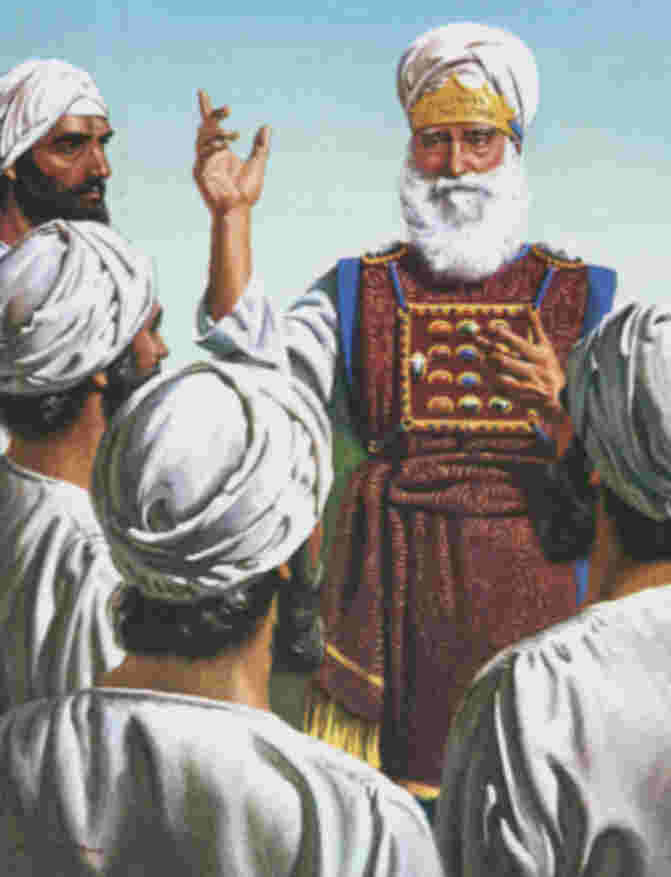
In relation, Yeshua the Messiah was "wrapped" in clothes, which is noted in the Gospel of Luke
Luke 2:1 And it came to pass in those days, that there went out a decree from Caesar Augustus, that all the world should be taxed. 2 (And this taxing was first made when Cyrenius was governor of Syria.) 3 And all went to be taxed, every one into his own city. 4 And Joseph also went up from Galilee, out of the city of Nazareth, into Judaea, unto the city of David, which is called Beth Lehem; (because he was of the house and lineage of David:) 5 To be taxed with Mary his espoused wife, being great with Child. 6 And so it was, that, while they were there, the days were accomplished that she should be delivered. 7 And she brought forth her Firstborn Son, and wrapped Him in swaddling clothes, and laid Him in a manger; because there was no room for them in the inn. 8 And there were in the same country shepherds abiding in the field, keeping watch over their flock by night. 9 And, lo, the Messenger of hwhy came upon them, and the Glory of hwhy shone round about them: and they were sore afraid. 10 And the Messenger said unto them, Fear not: for, behold, I bring you good tidings of great joy, which shall be to all People. 11 For unto you is born this day in the city of David a Saviour, who is Messiah hwhy. 12 And this shall be a Sign unto you; Ye shall find the Babe wrapped in swaddling clothes, lying in a manger.
If anyone ever asked themselves where Mary had possession of the swaddling cloths, we need to go back six months to the time where she went to see her cousin Elizabeth, which is noted in the Gospel of Luke
Luke 1:30 And the Messenger said unto her, Fear not, Mary: for thou hast found favour with hwhy. 31 And, behold, thou shalt conceive in thy womb, and bring forth a Son, and shalt call His Name, YESHUA. 32 He shall be great, and shall be called the Son of the Highest: and hwhy Elohim shall give unto Him the throne of His father David: 33 And He shall reign over the House of Jacob for ever; and of His Kingdom there shall be no end. 34 Then said Mary unto the Messenger, How shall this be, seeing I know not a man? 35 And the Messenger answered and said unto her, The Holy Spirit shall come upon thee, and the Power of the Highest shall overshadow thee: therefore also that Holy Thing which shall be born of thee shall be called the Son of Elohim. 36 And, behold, thy cousin, Elisabeth, she hath also conceived a son in her old age: and this is the sixth month with her, who was called barren. 37 For with hwhy nothing shall be impossible.... 39 And Mary arose in those days, and went into the hill country with haste, into a city of Juda; 40 And entered into the house of Zacharias, and saluted Elisabeth. 41 And it came to pass, that, when Elisabeth heard the salutation of Mary, the babe leaped in her womb; and Elisabeth was filled with the Holy Spirit:.. 56 And Mary abode with her about three months, and returned to her own house.
Mary, a descendant of Levi, went to her cousin Elizabeth, also a descendant of Levi, wife of Zechariah of the Priestly line of Aaron. Mary stayed there for three months until Elizabeth's son, John, was born. When Mary left to return to her home, Elizabeth would have most likely gave her some "Priestly rags" to "wrap" on the future Yeshua, when Mary gave birth to Him. It is my humble opinion that Yeshua was wrapped with the rags from the Priest's Garments which could also prove that Yeshua was of the Priestly line.
Verses ten through fourteen
THE BULLOCK
10 And you shall bring near ta-the bullock to the face of the Tent of Appointment: and Aaron and his sons shall support (lay) ta-their hands upon (over) the head of the bullock. 11 And you shall slaughter ta-the bullock (calf) to the Face of hwhy at the Entrance of the Tent of Appointment. 12 And you shall take from the blood of the bullock, and you shall give upon (over) the Horns of the Altar among your finger, and you shall shed (pour, spill out) ta-all of the blood to the Base (Foundation, Settled Area) of the Altar. 13 And you shall take ta-all of the kheylev-fat that covers (conceals) ta-the nearing areas, (nearness, inwards), and ta-the flap (caul, lobe) upon (over) the liver, and ta the two kidneys, and ta-the kheylev-fat that is upon (over) them, and you shall incense (smoke, fumigate, burn) to the Altar. 14 And ta-the flesh of the bullock, and ta-his skin, and ta-his dung, you shall burn up on the fire from outside by the Camp: He is a Sin Offering.
There are four horns at the Altar. It represents the corners of the hedge of protection, whether a person, or a nation, especially the nation of Israel, or the earth. When the animals are sacrificed, it is an act not just for sins and repentance but also for "restoring" the four corners for the hedges of the Israelite's protection and security.
Indirectly related, Yeshua noted the Altar regarding someone who has not gotten right with a neighbor, which is mentioned in the Gospel of Matthew
Matthew 5:23 Therefore if thou bring thy gift to the Altar, and there rememberest that thy brother hath ought against thee; 24 Leave there thy gift before the Altar, and go thy way; first be reconciled to thy brother, and then come and offer thy gift.
In this matter, Yeshua is saying to get right first with the brother, then offer the gift for the Altar.
These are the three parts mentioned regarding the bullock in this week's Torah portion passage were the kheylev-fat, the caul (lobe) of the liver, and the two kidneys.
Looking at the following words:
THE KHEYLEV-FAT
The Hebrew word for kheylev-fat is "khey-lehv"- Khet, Lamed, Bet (blx). It is from Strong's Concordance number 2459, and its definition
From an unused root meaning to be fat; fat, whether literally or figuratively; hence the richest or choice part: - X best, fat (-ness), X finest, grease, marrow.
This is where we get our modern English word "club". Anyone heard of a "club sandwich"? It is a "fat" sandwich.
It also means internal fatness of blessing. The Hebrew word for marrow is "kheylev", which is noted by king David in the book of Psalms
Psalm 63:5 My soul shall be satisfied as with marrow (blx) and fatness; and my mouth shall praise thee with joyful lips:
THE FLAP (CAUL, LOBE)
The Hebrew word for caul (lobe) is "yoh-theh-reth"- Yod, Tav, Resh, Tav (trty). It is from Strong's Concordance number 3508, and it definition
Feminine active participle of H3498; the lobe or flap of the liver (as if redundant or outhanging): - caul.
from 3498 "yah-thahr" (rty), and its definition
A primitive root; to jut over or exceed; by implication to excel; (intransitively) to remain or be left; causatively to leave, cause to abound, preserve: - excel, leave (a remnant), left behind, too much, make plenteous, preserve, (be, let) remain (-der, -ing, -nant), reserve, residue, rest.
On the dictionary.com website, the caul, according to Easton's 1897 Bible Dictionary says this:
(Heb. yothe'reth; i.e., "something redundant"), the membrane which covers the upper part of the liver (Ex. 29:13, 22; Lev.3:4, 10, 15; 4:9; 7:4; marg.,"midriff"). In Hos. 13:8 (Heb. seghor; i.e., "an enclosure") the pericardium, or parts about the heart,is meant.
THE KIDNEYS
The Hebrew word for kidneys is "keel-yah" (singular)- Kaph, Lamed, Yod, Heh (hylk). It is from Strong's Concordance number 3629, and its definition
Feminine of H3627 (only in the plural); a kidney (as an essential organ); figuratively the mind (as the interior self): - kidneys, reins.
from 3627 "k'lee" (ylk), and its definition
From H3615; something prepared, that is, any apparatus (as an implement, utensil, dress, vessel or weapon): - armour ([-bearer]), artillery, bag, carriage, + furnish, furniture, instrument, jewel, that is made of, X one from another, that which pertaineth, pot, + psaltery, sack, stuff, thing, tool, vessel, ware, weapon, + whatsoever.
from 3615 "kah-lah" (hlk) and its definition
A primitive root; to end, whether intransitively (to cease, be finished, perish) or transitively (to complete, prepare, consume): - accomplish, cease, consume (away), determine, destroy (utterly), be (when . . . were) done, (be an) end (of), expire, (cause to) fail, faint, finish, fulfil, X fully, X have, leave (off), long, bring to pass, wholly reap, make clean riddance, spend, quite take away, waste.
To a human, the kidneys in general represent the seat of the emotions.
IT JUST HIT ME!!!
Giving the glory to hwhy, there are three items here being separated, and it is probable that it relates to these three areas:
THE KHEYLAV FAT
This is fat. The brain also contains fat. Each organ has a "mind" of its own, and the fat is connected to them, which is the result of the organs. It is probable that the kheylev fat is symbolized by the brain, which is fat, and it is related to the MIND
THE FLAP (CAUL, LOBE)
This is connected to the liver, which represents strength, and it is probable that the caul (lobe) relates to the WILL
THE TWO KIDNEYS
It is well known that the kidneys relates to the EMOTIONS
These three items represents the three parts of the SOUL:
THE MIND
THE EMOTIONS
AND THE WILL
!!!!!hwhy Kl dbk
When someone sins, it is caused by the WILL, and when a sacrifice is made for an Israelite, it is an act to get the WILL back in line with hwhy and restore the WILL's relationship in one's resubmission to hwhy.
In verse thirteen of this week's Torah portion passage, the Hebrew text phrase for upon them is "aleyhen"- Ayin, Lamed, Yod, Heh, Nun Sophit (Nhyle). The Heh-Nun Sophit at the end (Nh) tells us that it is in the feminine plural suffix, which means that these three parts of the body are "feminine", which means that they symbolize the "soul" which is "feminine", which consists of the mind, emotions and will.
!!!hwhy Kl dbk
Looking at the word CROWN
The Hebrew word for crown is "ney-zehr"- Nun, Zayin, Resh (rzn). It is from Strong's Concordance number 5415, and its definition
From H5144; properly something set apart, that is, (abstractly) dedication (of a priest or Nazirite); hence (concretely) unshorn locks; also (by implication) a chaplet (especially of royalty): - consecration, crown, hair, separation.
from 5144 "nah-zahr" (rzn), and its definition
A primitive root; to hold aloof, that is, (intransitively) abstain (from food and drink, from impurity, and even from divine worship (that is, apostatize)); specifically to set apart (to sacred purposes), that is, devote: - consecrate, separate (-ing, self).
The English translation of crown can also be found in the Torah portion of T'rumah, in the book of Exodus
Numbers 25:23 You shall do (make) a Table of trees (wood) shittim (acacia) [shittim trees, shittim wood, acacia trees, acacia wood]: two cubits shall be his length, and a cubit shall be his width, and a cubit and the half shall be his height. 24 And you shall overlay (sheet over) him of pure gold, and you shall do (make) for him a Crown (Chaplet) of gold all around.
Looking at the word CROWN [T'RUMAH PASSAGE]
The Hebrew word for crown in the T'rumah passage is "zeyr"- Zayin, Resh (rz). It is from Strong's Concordance number 2213, and its definition
From H2237 (in the sense of scattering); a chaplet (as spread around the top), that is, (specifically) a border moulding: - crown.
from 2237 "zah-rahr" (rrz), and its definition
A primitive root (compare H2114); perhaps to diffuse, that is, (specifically) to sneeze: - sneeze.
from 2114 "zoor" (rwz), and its definition
A primitive root; to turn aside (especially for lodging); hence to be a foreigner, strange, profane; specifically (active participle) to commit adultery: - (come from) another (man, place), fanner, go away, (e-) strange (-r, thing, woman).
The two Hebrew words have the same two Hebrew letters: Zayin and Resh. It is a good argument to say that these two different Hebrew words are related to each other, and that Strong should have seen the co-relation between them.
Verses fifteen through eighteen
THE ONE RAM
15 And you shall take ta-the one ram; and Aaron and his sons, they shall support (lay) ta-their hands upon (over) the head of the ram. 16 And you shall slaughter ta-the ram, and you shall take ta-his blood, and you shall strew (sprinkle) upon (over) the Altar all around. 17 And you shall dismember ta-the ram by his fragments (pieces, parts), and you shall wash his nearing areas (nearness, inwards), and his shoulder legs (lower shoulder legs), and you shall give upon (over) his fagments (pieces, parts), and upon (over) his head. 18 And you shall incense (smoke, fumigate, burn) ta-all of the ram at the Altar: He is an Elevation Offering (Ascension Offering, Burnt Offering) to hwhy: a pleasant scent, he is a Fire Offering to hwhy.
This is like the Exodus Passover lamb, an immature ram, which is noted in the Torah portion of Bo, in the book of Exodus, in which the whole lamb has to be cooked in the fire.
Why did hwhy require them to wash the inwards and legs? Why not the head or any other part of the body? I'm guessing it relates to their soul- their act to submit to hwhy, and their walk with hwhy., in which their "soul" is "washed", symbolic of the Ruakh HaKodesh (the Holy Spirit), to be symbolically cleansed from the sins of the person who provided the animal to be sacrificed for thier sins.
!!!hwhy Kl dbk
Looking at the word SHOULDER LEG (LOWER SHOULDER LEG)
The Hebrew word for shoulder legs (lower shoulder legs) is "kah-rah"- Kaph, Resh, Ayin (erk). It is from Strong's Concordance number 3767, and its definition
From H3766; the leg (from the knee to the ankle) of men or locusts (only in the dual): - leg.
from 3766 "kah-rah" (erk), and its definition
A primitive root; to bend the knee; by implication to sink, to prostrate: - bow (down, self), bring down (low), cast down, couch, fall, feeble, kneeling, sink, smite (stoop) down, subdue, X very.
This leg is the front leg which "bends its knees" as if to bow and worship. This is a symbolism of an act for the Israelites to bow and worship to hwhy, and it applies to us following believers in Yeshua that we are to sacrifice ourselves to bow and worship Yeshua, the Messiah.
!!!hwhy Kl dbk
Verses nineteen and twenty
THE SECOND RAM
19 And you shall take ta the second ram; and Aaron and his sons shall support (lay) ta-their hands upon (over) the head of the ram. 20 And you shall slaughter ta-the ram, and you shall take from his blood, and shall give upon the tip (lobe) of the ear of Aaron, and upon the tip (lobe) of the ear of his sons, at the right, and upon the thumb of their right hand, and upon the thumb (toe) of their right foot, and you shall strew (sprinkle) ta-the blood upon (over) the Altar all around.
This second ram is the Ram of the Consecration which is noted later in this week's Torah portion chapter.
Notice that the ram's blood was placed on the Priests' right side of their ears, thumb and big toe. The right side symbolizes the side of "strength", and Yeshua was seated at the Right Hand of the Father, which is noted in the apostle Paul's letter to the assembly in Colossia
Colossians 3:1 If ye then be risen with Messiah, seek those things which are above, where Messiah sitteth on the Right Hand of hwhy.
The reason that the blood was applied to these three places, because it represents these three areas:
Tip of The Right Ear: Hearing the Word
The Right Thumb: Working and doing the Word
The Right Big Toe: Walking in the Word
These three imply in following Yeshua, the Eternal Living Word.
Indiretly related, these two rams could also be compared to the two goats in Yom Kippur, one dedicated to hwhy, and one for the Azazel scapegoat.
Verses twenty-one and twenty two
21 And you shall take from the blood which is upon (over) the Altar and from the Oil of the Anointing, and you shall spurt (besprinkle in expiation, sprinkle) upon (over) Aaron and upon (over) his Garments, and upon (over) his sons and upon (over) the Garments of his sons with him: and he shall be Sacred (Holy), and his Garments, and his sons, and the Garments of his sons with him. 22 And you shall take from the ram the kheylev-fat, and the tail fat, and ta-the kheylev-fat that covers (conceals) ta-the nearing areas (nearness, inwards), and ta the flap (caul, lobe) of the liver, and ta the two kidneys, and ta-the keylev-fat which is upon (over) them, and ta the right hip leg; for he is a Ram of Consecration (Fulfillment):
Aaron and his sons would start their services with them and the bloody garments. The purpose of these represents the following:
Blood: Yeshua, the Living Sacrifice who shed His Blood and who covers us in His Blood
Oil of Annointing: The Ruakh HaKodesh (The Holy Spirit) who annoints us
The Priests need to be "covered" with the blood, and "annointed" by the oil to do the Work of hwhy.
We as believers in Yeshua who are covered in the Blood of Messiah are doing His Work, which the apostle Paul noted in the book of Hebrews
Hebrews 9:14 How much more shall the Blood of Messiah, who through the Eternal Spirit offered Himself without spot to hwhy, purge your conscience from dead works to serve the Living Elohim?
Looking at the word HIP LEG
The Hebrew word for hip leg is "shoke"- Shin, Vav, Kuph (qws). It is from Strong's Concordance number 7785, and it definition
From H7783; the (lower) leg (as a runner): - hip, leg, shoulder, thigh.
from 7783 "shuke" (qws), and its definition
A primitive root; to run after or over, that is, overflow: - overflow, water.
This is the running leg which is mainly used for walking. This is the act for the Israelites to walk in hwhy. This also applies to us as following believers in Yeshua to walk in Him and in His light.
!!!hwhy Kl dbk
Verses twenty three through twenty five
THE BREADS
23 And one round loaf of bread, and one challah cake of bread of oil, and one thin cake (wafer) from the twig basket (willow twig basket) of the unleavened which is to the Face of hwhy: 24 And you shall put (set) the allness upon (over) the palms of Aaron, and upon (over) the palms of his sons; and you shall wave them of a Wave Offering to the Face of hwhy. 25 And you shall take them from their hands, and you shall make incense (smoke, fumigate, burn) to the Altar upon the Elevation Offering (Ascension Offering, Burnt Offering), for a pleasant scent to the Face of hwhy: He is a Fire Offering to hwhy.
These breads in their hands are representations of Yeshua, the Unleavened Bread and the oil symbolized by the Ruakh HaKodesh (the Holy Spirit). Putting these breads in their hands is saying to them "Do hwhy's Work through Yeshua, the Living Bread, by the Ruakh HaKodesh (the Holy Spirit)".
Verses twenty six through twenty eight
THE RAM OF THE CONSECRATION
26 And you shall take ta-the breast from the Ram of the Consecration (Fulfillment) which is for (belongs to) Aaron, and you shall wave him for a Wave Offering to the Face of hwhy: and shall be to you for rationing (sharing, a portion, allotment). 27 And you shall sanctify ta the breast of the Wave Offering, and ta the hip leg of the Heave Offering (Raise Offering) which is waved and the which is heaved up (raised up) from the Ram of the Consecration (Fulfillment) from which shall be for [(belong to)] Aaron and from which shall be for [(belong to)] his sons: 28 And shall be for [(belong to)] Aaron and for (to) his sons for a Statute of Ages from ta the Sons of Israel: for he is a Heave Offering (Raise Offering): and shall be a Heave Offering (Raise Offering) from ta the Sons of Israel from the Sacrifices of their Peace Offerings, of their Heave Offerings (Raise Offerings) to hwhy.
This relates to the Second Ram which the blood was used ealier to be placed on the Priests' right ear, right thumb and right big toe.
Verses twenty nine and thirty
THE HIGH PRIEST GARMENTS
29 And the Sacred (Holy) Garments which shall be for [(belong to)] Aaron shall be for [(belong to)] his sons after him to be anointed in them, and to (for) fill (filling, consecrate, consecrating) ta-their hands in them. 30 And the Priest at his stead from his sons shall clothe them seven days which shall enter (go) to the Tent of Appointment to minister in the Sacred Area (Sanctuary, Holy Area).
An example of passing the High Priest Garments is when Aaron had to give the High Priest Garments to his son, Eleazar, which is noted in the Torah portion of Khukath, in the book of Numbers.
Numbers 20:22 And pulled up (journeyed) from Kadesh. And the Sons of Israel, of all of the Congregation, they came at the Hor of the Mount [(Mount of the Hor, Mount Hor)]. 23 And hwhy spoke to Moses and to Aaron on the Hor of the Mount [(Mount of the Hor, Mount Hor)], upon the border of the land of Edom, to say, 24 Aaron shall be gathered to his People: for shall not go to the land which I have given to the Sons of Israel, upon which you rebelled at ta-My Mouth by the waters of Meribah. 25 Take ta-Aaron, and ta-Eleazar, his son, and ascend them at the Hor of the Mount [(Mount of the Hor, Mount Hor)]: 26 And shall strip ta-Aaron of ta-his Garments, and you shall have ta-Eleazar, his son, clothe them: and Aaron shall be gathered and shall die there. 27 And Moses did as the which hwhy commanded: and they acended to the Hor of the Mount [(Mount of the Hor, Mount Hor)] to the eyes of all of the Congregation. 28 And Moses stripped ta-Aaron of ta-his Garments, and had ta-Eleazar, his son clothed them; and Aaron died there in the head of the mountain (the Hor): and Moses and Eleazar came down from the mountain (the Hor).
When Eleazar took over the High Priesthood and wore the garments, he would be wearing them for seven days according to this week's Torah portion passage.
It has been passed down from generation to generation until it came to Caiaphas, the High Priest, until Yeshua became the current and Eternal High Priest from the result of Caiaphas renting his High Priest garment and nullified his High Priestship. This is what the apostle Paul noted in the book of the Hebrews
Hebrews 8:1 Now of the things which we have spoken this is the sum: We have such an High Priest, who is set on the Right Hand of the Throne of the Majesty in the heavens;
When Yeshua took over the High Priesthood from Caiaphas on Passover, Yeshua wore an Unseamed Garment. Though it was removed from Him at His crucifixion, the Garment was not ripped. Because the Garment was not worn for seven days, according to the Commandment of this week's Torah portion passage, there is no physical High Priest. Though Yeshua is our Eternal High Priest according to the book of Hebrews, He nullified the physical High Priesthood, so that He could be "the Eternal Kingdom High Priest" and be The High Priest through us, since our bodies are His Temples.
!!!hwhy Kl dbk
Verses thirty-one through thirty four
THE CONSECRATION OF THE RAM (A.K.A. THE SECOND RAM) CONTINUED
31 And you shall take ta-the Ram of the Consecration (Fulfillment), and you shall boil ta-his flesh in the Sacred (Holy) Place. 32 And Aaron and his sons shall eat ta-the flesh of the ram and ta-the bread which is in the twig basket (willow twig basket) at the Entrance of the Tent of Appointment. 33 And they shall eat them which the Atonement is in them to consecrate (fill) ta-their hand to sanctify them: and a stranger shall not eat, for they are Sacred (Holy). 34 And if shall yether-remain (be remnant, be left) from the flesh of the Consecration (Fulfillment), and from the bread until the breaking period (morning), and you shall burn up ta-the yether-remainder (remnant, leftover) in the fire: shall not be eaten, for he is Sacred (Holy).
The Commandment to burn the flesh in the breaking period (morning) in verse thirty four of this week's Torah portion passage was based from the Passover lamb sacrifice, which is noted in the Torah portion of Bo, in the book of Exodus
Exodus 12:8 And they shall eat ta-the flesh in this night roasted of fire and unleavened bread; they shall eat upon bitters (bitter foods, bitter herbs). 9 You shall not eat from him raw (tough), and sodden (boiling) from boiling in water, for but roasted of fire; his head shall be upon his legs and upon his nearness (inwards). 10 And you shall not leave (remain) from him until breaking period (morning); and of that remaining (left) from him until breaking period (morning) you shall burn in the fire.
This is a seven day ceremonial festivity for the Levitical Priests before they officially start their Priestly Service.
In verse thirty three of this week's Torah portion passage, it says that the stranger shall not eat of it, because it only relates to Aaron and his sons who are doing the Priestly Acts in the Tabernacle.
Verses thirty five through thirty seven
35 And you shall do to Aaron and to his sons, as the thus, according to [(as)] all which I have commanded you: You shall fill (consecrate) their hand seven days, 36 and you shall do (offer) a bullock for a Sin Offering for the day upon (over) the Atonements: and you shall purify (cleanse) upon (over) the Altar, in your Atonement upon (over) him, and you shall anoint him to sanctify him. 37 Seven days you shall atone upon (over) the Altar, and you shall sanctify him; and shall be the Altar of a Sacred (Holy) of Sacreds (Holies) [(Sacred of Sacreds, Holy of Holies)]: of anything that touches on the Altar shall be Sacred (Holy).
This act is just for the seven days in preparation for Aaron and his sons to start their Priestly Acts in the Tabernacle.
Verses thirty eight through forty six
THE DAILY SACRIFICES
38 And this is which you shall do (offer) upon (over) the Altar; two sheep, sons of a year, by (for) the day, continually. 39 ta-the one sheep you shall do (offer) in the breaking period (morning); and ta the second sheep you shall do (offer) between the mixing periods (evenings): 40 And a tenth of flour overflowed (mixed) in the oil, a fourth of the hin, beaten; and a Drink Offering (Libation Offering) of a fourth of the hin of wine shall be for the one sheep. 41 And ta the second sheep you shall do (offer) between the mixing periods (evenings), and you shall do to her as (like) the Donation Offering (Tribute Offering, Food Offering, Grain Offering, Apportion Offering) of the breaking period (morning) and as (like) her Drink Offering (Libation Offering), for a pleasant scent of a Fire Offering to hwhy, 42 a Continual Elevation Offering (Ascension Offering, Burnt Offering) for your generations at the Entrance of the Tent of Appointment to the Face of hwhy which I will appoint to you there to speak to you there. 43 And I will appoint there to the Sons of Israel and shall be sanctified in My Glory. 44 And I will sanctify ta-the Tent of Appointment, and ta-the Altar: And I will sanctify ta-Aaron and ta-his sons for the Priestship (to do Priestly Acts) to Me. 45 And I will tabernacle in the midst of the Sons of Israel, and I will be to them for Elohim. 46 And they shall know for I am hwhy, their Elohim, which brought them out from the land of Egypt to tabernacle Myself in their midst: I am hwhy, their Elohim.
The Daily Sacrifice is also noted in the Torah portion of Pinkhas, in the book of Numbers
Numbers 28:3 And you shall say to them, This is the Fire Offering which you shall bring near to hwhy; two perfect sheep of sons of a year, by the day, of a Continual Elevation Offering (Ascension Offering, Burnt Offering). 4 You shall do (offer) ta-the one sheep in the breaking period (morning), and you shall do (offer) ta the second sheep between the mixing periods (evenings); 5 and the tenth of the ephah of flour for a Donation Offering (Tribute Offering, Food Offering, Grain Offering, Apportion Offering), overflowed (mixed) in beaten (crushed, ?stamped?) oil, of a fourth of the hin. 6 A Continual Elevation Offering [(Continual Ascension Offering, Continual Burnt Offering)] that was done (offered) on Mount Sinai for a pleasant scent of a Fire Offering to hwhy, 7 and his Drink Offering (Libation Offering) shall be a fourth of the hin for the one sheep: in the Sacred Area (Sanctuary) shall be the pouring (libation) of the of the Drink Offering (Libation Offering), of a strong drink to hwhy. 8 And you shall do (offer) ta the second sheep between the mixing periods (evenings): as a Donation Offering (Tribute Offering, Food Offering, Grain Offering, Apportion Offering) of the breaking period (morning), and as his Drink Offering (Libation Offering), you shall do (offer) of a Fire Offering of a pleasant scent to hwhy.
Indirectly related, this would apply to us as believers in Yeshua to offer ourselves to be daily sacrifices, which the apostle Paul noted in his letter to the assembly in Rome
Romans 12:1 I beseech you therefore, brethren, by the Mercies of hwhy, that ye present your bodies a living sacrifice, Holy, acceptable unto hwhy, which is your reasonable service. 2 And be not conformed to this world: but be ye transformed by the renewing of your mind, that ye may prove what is that good, and acceptable, and Perfect, Will of hwhy.
Yeshua also noted this, which is noted in the Gospel of Luke
Luke 9:23 And He said to them all, If any man will come after Me, let him deny himself, and take up his cross daily, and follow Me.
The purpose of the believer's daily sacrifice is to be set apart from the world on a daily basis, like the Continual Elevation Offerings from the Levitical Priests who were set apart to serve hwhy daily.
This is what the apostle John noted in his book of Revelation
Revelation 18:4 And I heard another voice from the heavens, saying, Come out of her, My People, that ye be not partakers of her sins, and that ye receive not of her plagues.
In verse forty-one of this week's Torah portion passage, when it says "between the mixing periods", which is in the Hebrew text "beyn ha-aravim" (Mybreh Nyb), and it means after dusk and before dawn, meaning in the complete darkness of the night.
CHAPTER 30
Exodus 30:1-10
Exo 30:1 And you shall do (make) an Altar incensing (smoking, fuming, burning) incense (smoke, fume, burning): you shall do (make) him of trees (wood) of shittim (acacia) [shittim trees, shittim wood, acacia trees, acacia wood]. 2 A cubit shall be his length, and a cubit shall be his width; shall be square: and two cubits shall be his height: from him shall be his Horns. 3 And you shall overlay (sheet over) him of pure gold ta-his roof (top), and ta-his walls all around, and ta-his Horns; And you shall do (make) for him a Crown (Chaplet) of gold all around. 4 And you shall do (make) for him two Rings of gold from under to his Crown (Chaplet), upon (over) the two of his ribs (sides) you shall do (make) upon (over) the two of his sides; And shall be for housings for the Poles to bear (carry. lift up) him on them. 5 And you shall do (make) ta-the Poles of trees (wood) of shittim (acacia) [shittim trees, shittim wood, acacia trees, acacia wood], and you shall overlay (sheet over) them of gold. 6 And you shall give him to the face of the Veil which is upon (over) the Ark of the Testimony (Witness) to the face of the Mercy Seat (Atoning Seat) which is upon (over) the Testimony (Witness) which I will appoint to you there. 7 And Aaron shall incense (smoke, fume, burn) the Incense of Spices upon him in the breaking period (morning), in the breaking period (morning): shall incense (smoke, fume, burn) in his trimming (dressing, gooding, cheering, make good, make well) ta-the Lamps. 8 And Aaron in ascending (elevating) ta-the Lamps between the mixing periods (evenings) shall incense (smoke, fume, burn) incense (smoke, fume, burning) continually to the Face of hwhy for your generations. 9 You shall not ascend (elevate) him strange incense (smoke, fume, burning) upon (over) him, and an Elevation Offering (Ascension Offering, Burnt Offering), and a Donation Offering (Tribute Offering, Food Offering Grain Offering, Apportion Offering); and you shall not pour out (libate) a Drink Offering (Libation Offering) upon (over) him. 10 And Aaron shall atone upon his Horns once in the year from the blood of the Sin Offering of the Atonements: Shall atone upon him once in the year for your generations: he shall be a Sacred (Holy) of Sacreds (Holies) [(Sacred of Sacreds, Holy of Holies)] to hwhy.
(NOTE: Not all verses will have comments)
Verses one through six
THE ALTAR OF THE INCENSE (OR THE GOLDEN CENSER)
1 And you shall do (make) an Altar incensing (smoking, fuming, burning) incense (smoke, fume, burning): you shall do (make) him of trees (wood) of shittim (acacia) [shittim trees, shittim wood, acacia trees, acacia wood]. 2 A cubit shall be his length, and a cubit shall be his width; shall be square: and two cubits shall be his height: from him shall be his Horns. 3 And you shall overlay (sheet over) him of pure gold ta-his roof (top), and ta-his walls all around, and ta-his Horns; And you shall do (make) for him a Crown (Chaplet) of gold all around. 4 And you shall do (make) for him two Rings of gold from under to his Crown (Chaplet), upon (over) the two of his ribs (sides) you shall do (make) upon (over) the two of his sides; And shall be for housings for the Poles to bear (carry. lift up) him on them. 5 And you shall do (make) ta-the Poles of trees (wood) of shittim (acacia) [shittim trees, shittim wood, acacia trees, acacia wood], and you shall overlay (sheet over) them of gold. 6 And you shall give him to the face of the Veil which is upon (over) the Ark of the Testimony (Witness) to the face of the Mercy Seat (Atoning Seat) which is upon (over) the Testimony (Witness) which I will appoint to you there.
THE SYMBOLIC MEANINGS OF THE ALTAR OF THE FUMING (BURNING) OF INCENSE (OR THE GOLDEN CENSOR)
Shittim Wood: Man, also could be Scourging and Piercing and Lashing
Gold: Kingdom, Eternal, Perfection
Spices/Incense: Worship (source: maranathalife.com)/Prayers of the Saints
Incense: Prayers of the People/Saints
GENDER:
Altar of the Fuming (Burning) of Incense: MALE
Crown (Wreath): (MALE?)
Horns: FEMALE
Rings: FEMALE
Poles: MALE
The Altar of the Incense, in U.S. measurements, is 1 1/2 feet long, 1 1/2 feet wide and 3 feet high.
Question: Two chapters ago of this week's Torah portion, the subject was about the items for the Tent of Appointment. This week's Torah portion's previous chapter was about the Priests and the Priests' Garments. How come the plan of the Altar of Incense was not mentioned until now two chapters later? Why wasn't it placed with the items for the Tent of Appointment in the Torah portion of T'rumah, in the book of Exodus? I don't have an answer to this at this time.
Mark Moses of El Shaddai Ministries noted that hwhy said later in the Torah to not to burn strange incense as noted in this chapter
Exodus 30:9 You shall not ascend (elevate) him strange incense upon (over) him,...
Mark Moses also noted that we are like inense (as well as our prayers) and are a pleasant scent to hwhy. Thank you Mark.
The apostle Paul noted the Golden Censer in the Holy of Holies, which is noted in the book of the Hebrews
Hebrew 9:3 And after the second Veil, the Tabernacle, which is called the Holiest of all; 4 Which had the Golden Censer...
The apostle John noted the prayer of the Saints and the Golden Censer in the end times, which is noted in the book of Revelation
Revelation 8:3 And another angel came and stood at the Altar, having a Golden Censer; and there was given unto him much Incense, that he should offer it with the prayers of all saints upon the Golden Altar which was before the Throne. 4 And the smoke of the Incense, which came with the prayers of the Saints, ascended up before hwhy out of the angel's hand. 5 And the angel took the Censer, and filled it with fire of the Altar, and cast it into the earth: and there were voices, and thunderings, and lightnings, and an earthquake.
This is an example image of what the Altar of Incense could have looked like
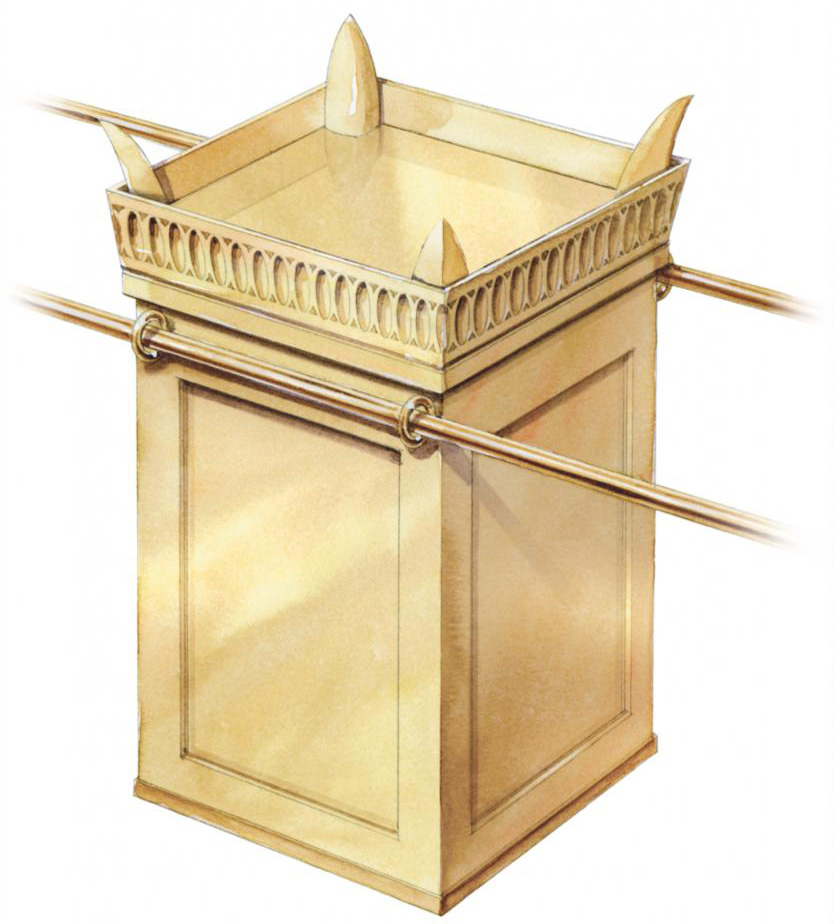
Looking at the word INCENSING (SMOKING, FUMING, BURNING)
The Hebrew word forincensing (smoking, fuming, burning) is "meek-tahr"- Mem, Kuph, Tet, Resh (rjqm). It is from Strong's Concordance number 4729, and its definition
From H6999; something to fume (incense) on, that is, a hearth place: - to burn . . . upon.
from 6999 "kah-tahr" (rjq), and its definition
A primitive root (rather identical with H7000 through the idea of fumigation in a close place and perhaps thus driving out the occupants); to smoke, that is, turn into fragrance by fire (especially as an act of worship): - burn (incense, sacrifice) (upon), (altar for) incense, kindle, offer (incense, a sacrifice).
This Hebrew word "meek-tahr" is the only time it exists in the entire Tanakh.
Verses seven and eight
7 And Aaron shall incense (smoke, fume, burn) the Incense of Spices upon him in the breaking period (morning), in the breaking period (morning): shall incense (smoke, fume, burn) in his trimming (dressing, gooding, cheering, make good, make well) ta-the Lamps. 8 And Aaron in ascending (elevating) ta-the Lamps between the mixing periods (evenings) shall incense (smoke, fume, burn) incense (smoke, fume, burning) continually to the Face of hwhy for your generations.
In verse seven of this week's Torah portion passage, the King James Version translated to do it "in the morning"
(KJV) 7 And Aaron shall burn thereon sweet incense every morning: when he dresseth the lamps, he shall burn incense upon it.
Aaron was only told one time to do it, which is from the Hebrew, "ba-boker ba-boker" (rqbb rqbb), which literally translates "in the breaking period (morning), in the breaking (morning)", meaning every time during the breaking period (morning), during the early part of the day before the sun arose.
In verse eight of this week's Torah portion passage, when it says "between the mixing periods", which is in the Hebrew text "beyn ha-aravim" (Mybreh Nyb), it means after dusk and before dawn, meaning in the complete darkness of the night.
The King James Version translates verse eight of this week's Torah portion passage this way:
(KJV) 8 And when Aaron lighteth the lamps at even, he shall burn incense upon it, a perpetual incense before hwhy throughout your generations.
Question: "What is that the phrase the translators should have interpreted"? This phrase "at even" is taken from the Hebrew text phrase "beyn ha-arabbim" (Mybreh Nyb). Beyn is interpreted "between", and that is understood. Ha-arabbim is commonly interpreted "the evenings"- in KJV "at even".
Looking at the following words:
BETWEEN
The Hebrew word for between is "beyn"- Bet, Yod, Nun Sophit (Nyb). It is from Strong's Concordance number 996, and its definition
(Sometimes in the plural masculine or feminine); properly the constructively contracted form of an otherwise unused noun from H995; a distinction; but used only as a preposition, between (repeated before each noun, often with other particles); also as a conjugation, either... or: - among, asunder, at, between (-twixt . . . and), + from (the widest), X in, out of, whether (it be... or), within.
Beyn is translated as "between".
MIXING PERIOD
The Hebrew word for mixing period is "eh-rehv"- Ayin, Resh, Bet (bre). Its is from Strong's Concordance number 6153, and its defintion
From H6150; dusk: - + day, even (-ing, tide), night.
from 6150 "ah-rahv" (bre), and its definition
A primitive root (rather identical with H6148 through the idea of covering with a texture); to grow dusky at sundown: - be darkened, (toward) evening.
from 6148 "ah-rahv" (bre), and its definition
A primitive root; to braid, that is, intermix; technically to traffic (as if by barter); also to give or be security (as a kind of exchange): - engage, (inter-) meddle (with), mingle (self), mortgage, occupy, give pledges, be (-come, put in) surety, undertake.
Erev is translated as "evening" or "mixing".
What sticks out in this definition are the meanings "braid", "mingle", and "intermix"- it also could be "mix". These interpretations provide the best possibilities for the word. To get to the point, "arabbim" is plural, and take the interpretation "mix" and pluralize it, and we get "mixings" or "mixing periods". So the phrase should actually say "between the mixing periods", meaning that this phrase could be used interchangeably, whether for the purpose of the night, or for the purpose of the day. A good example is in the Exodus story where the Israelite people are kill the Passover lamb "between the mixing periods", which is noted in the Torah portion of Bo, in the book of Exodus
Exodus 12:5 A lamb shall be a perfect (complete) remembered one (male) of a son of a year: shall be for yourselves from the lambs, and you shall take from the kids (young goats): 6 And shall be for you to keep (guard, watch, observe) until the four ten (fourteen) day of (for) this renewed month: and all of the Assembly of the Congregation of Israel, they shall slaughter him between the mixing periods.
This means that the Israelites were to kill it "between the mixing periods" in the night meaning the mixing period from light to dark after sunset below the horizon, and the mixing from dark to light before sunrise above the horizon (Note: the Passover lamb was intended to be killed after it becomes dark, otherwise the Angel of Death would not have come in the middle of the night).
In verse eight of this week's Torah portion passage, it means that Aaron was to set up the Lamp and burn incense upon it "between the mixing periods", which occurs on the beginning of the new Biblical day.
Verses nine and ten
9 You shall not ascend (elevate) him strange incense (smoke, fume, burning) upon (over) him, and an Elevation Offering (Ascension Offering, Burnt Offering), and a Donation Offering (Tribute Offering, Food Offering Grain Offering, Apportion Offering); and you shall not pour out (libate) a Drink Offering (Libation Offering) upon (over) him. 10 And Aaron shall atone upon his Horns once in the year from the blood of the Sin Offering of the Atonements: Shall atone upon him once in the year for your generations: he shall be a Sacred (Holy) of Sacreds (Holies) [(Sacred of Sacreds, Holy of Holies)] to hwhy.
Aaron and the Priests were told not to offer strange offerings, incense or sacrifices to hwhy. A perfect example of this was noted when Nadab and Abihu offered strange fire to hwhy and were burned to death as noted earlier, which is noted in the Torah portion of Sh'mini, in the book of Exodus
Leviticus 10:1 And Nadab and the Abihu, the sons of Aaron, they took a man his censer, and they gave fire in them, and they set incense upon her, and they brought near a strange fire to the Face of hwhy which was not commanded them. 2 And a fire, she went out from of the Face of hwhy, and she consumed them, and they died to the Face of hwhy.
As a result, the two brothers reaped what they sowed by being a fire unto themselves with the help of hwhy, and it cost them their lives.
When it says in verse ten of this week's Torah portion passage that Aaron was to make atonement once a year, it is referring to the Yom Kippur Sacrifice that the High Priest does once a year, which is noted located in the Torah portion of Akharey Moth, in the book of Leviticus, in chapter sixteen.
Also, Yeshua became the Atonement for us, which the Apostle Paul noted in his letter to the assembly in Rome
Romans 5:8 But the Adon commendeth His Love toward us, in that, while we were yet sinners, Messiah died for us. 9 Much more then, being now justified by His Blood, we shall be saved from wrath through Him. 10 For if, when we were enemies, we were reconciled to hwhy by the death of His Son, much more, being reconciled, we shall be saved by His Life. 11 And not only so, but we also joy in hwhy through our Adon Yeshua, the Messiah, by whom we have now received the Atonement.
Yeshua atoned our sins for us that we might have life in Him by His Blood.
!!!!!hy wllh
That ends this week's Torah portion commentary.
Any questions or comments can be written to
the.aleph-tav.project@msn.com
SHABBATH SHALOM

_______________________________________________________________________________________________________________________________________________
_______________________________________________________________________________________________________________________________________________
Copyright 2014 The Aleph-Tav Project - NVU's Website Design Software by The Premier Group